Advantages and Disadvantages of Observation as a Research Method
VerifiedAdded on 2023/01/11
|16
|6256
|27
AI Summary
This document discusses the key purpose of observation as a research method, outlining its advantages and disadvantages. It also explores four dimensions that distinguish various approaches to observation. Additionally, it provides insights on minimizing observer bias and evaluates the ethics of concealed observation. The document further delves into advancements in technology for data gathering via online survey questionnaires, discussing mechanisms for administering online questionnaires and outlining the advantages and disadvantages of this approach.
Contribute Materials
Your contribution can guide someone’s learning journey. Share your
documents today.
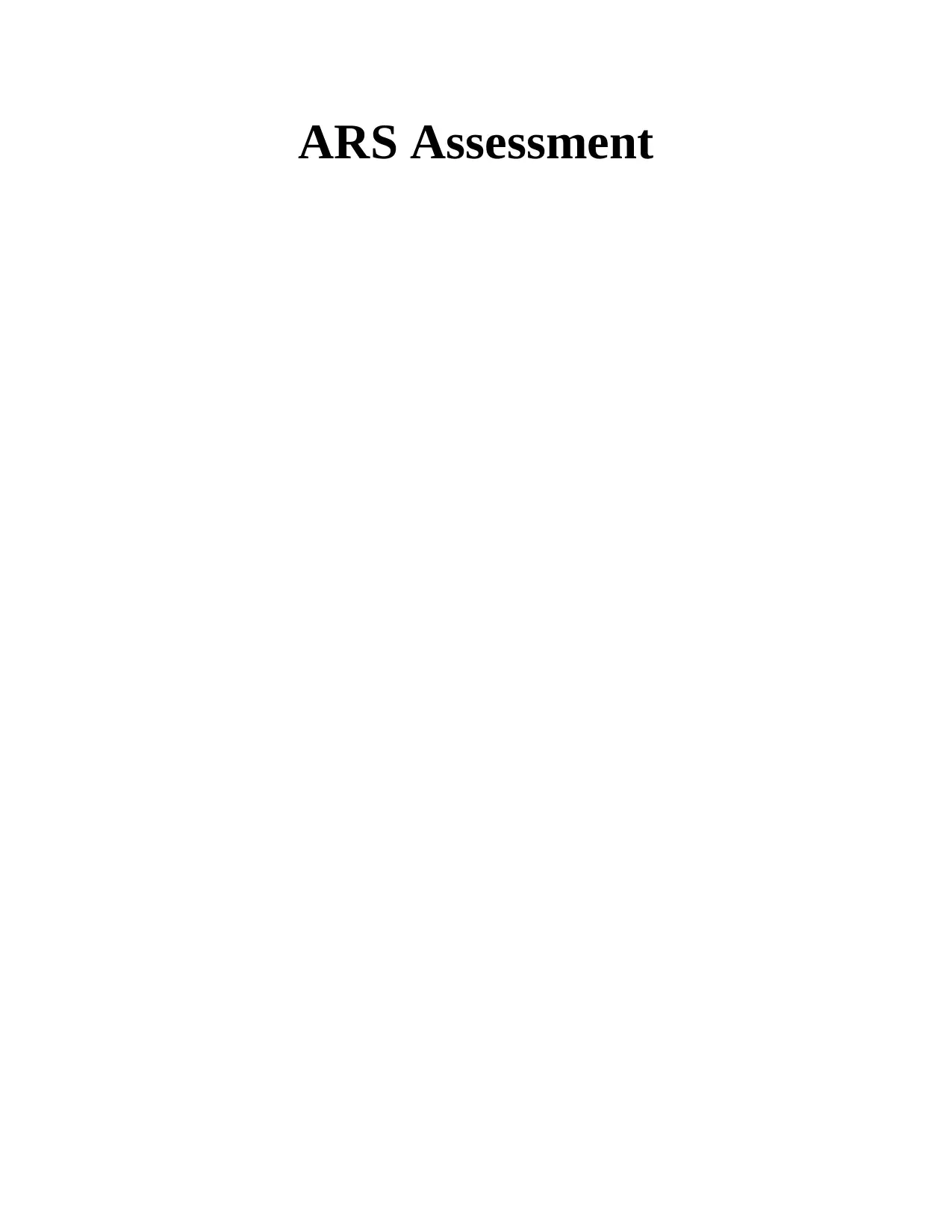
ARS Assessment
Secure Best Marks with AI Grader
Need help grading? Try our AI Grader for instant feedback on your assignments.
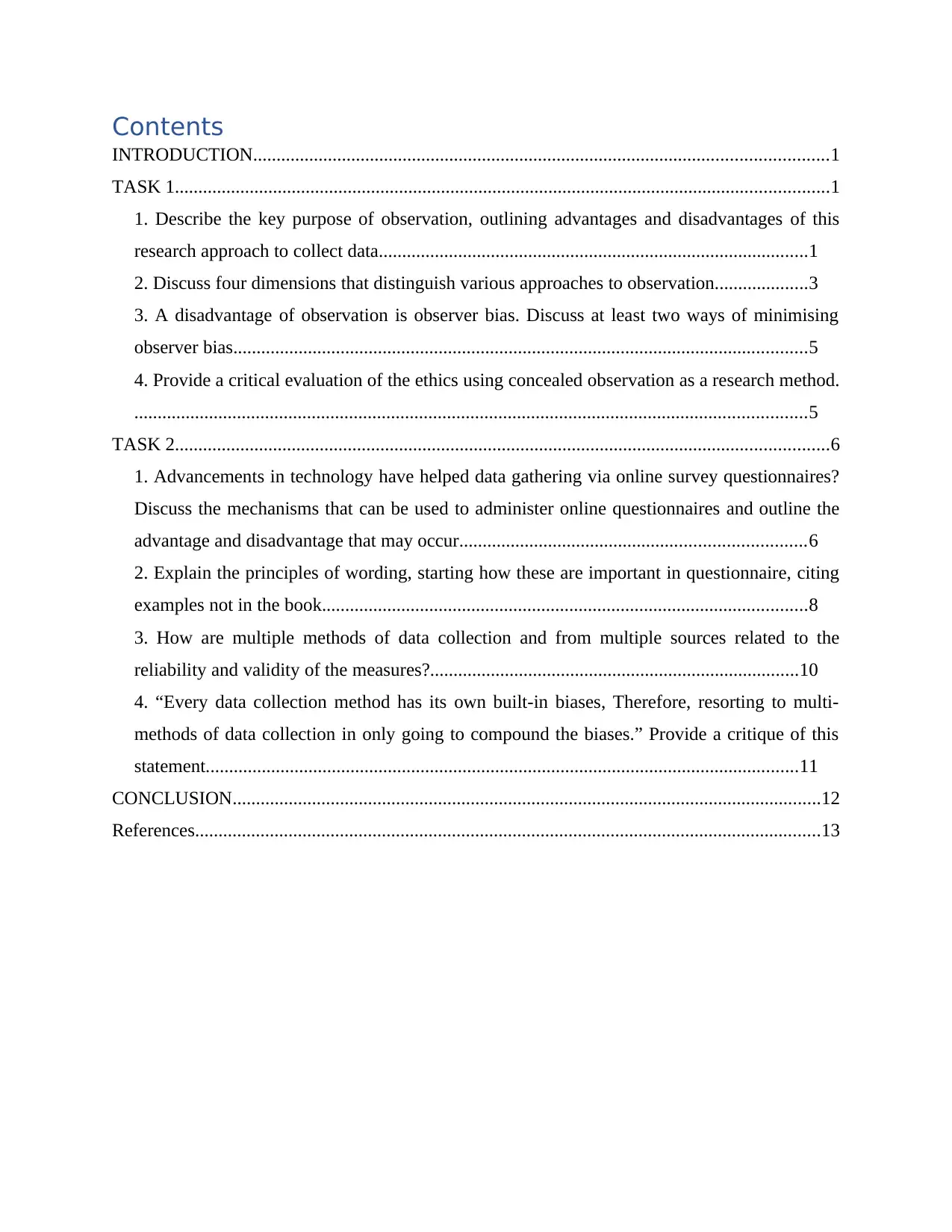
Contents
INTRODUCTION...........................................................................................................................1
TASK 1............................................................................................................................................1
1. Describe the key purpose of observation, outlining advantages and disadvantages of this
research approach to collect data............................................................................................1
2. Discuss four dimensions that distinguish various approaches to observation....................3
3. A disadvantage of observation is observer bias. Discuss at least two ways of minimising
observer bias...........................................................................................................................5
4. Provide a critical evaluation of the ethics using concealed observation as a research method.
................................................................................................................................................5
TASK 2............................................................................................................................................6
1. Advancements in technology have helped data gathering via online survey questionnaires?
Discuss the mechanisms that can be used to administer online questionnaires and outline the
advantage and disadvantage that may occur..........................................................................6
2. Explain the principles of wording, starting how these are important in questionnaire, citing
examples not in the book........................................................................................................8
3. How are multiple methods of data collection and from multiple sources related to the
reliability and validity of the measures?...............................................................................10
4. “Every data collection method has its own built-in biases, Therefore, resorting to multi-
methods of data collection in only going to compound the biases.” Provide a critique of this
statement...............................................................................................................................11
CONCLUSION..............................................................................................................................12
References......................................................................................................................................13
INTRODUCTION...........................................................................................................................1
TASK 1............................................................................................................................................1
1. Describe the key purpose of observation, outlining advantages and disadvantages of this
research approach to collect data............................................................................................1
2. Discuss four dimensions that distinguish various approaches to observation....................3
3. A disadvantage of observation is observer bias. Discuss at least two ways of minimising
observer bias...........................................................................................................................5
4. Provide a critical evaluation of the ethics using concealed observation as a research method.
................................................................................................................................................5
TASK 2............................................................................................................................................6
1. Advancements in technology have helped data gathering via online survey questionnaires?
Discuss the mechanisms that can be used to administer online questionnaires and outline the
advantage and disadvantage that may occur..........................................................................6
2. Explain the principles of wording, starting how these are important in questionnaire, citing
examples not in the book........................................................................................................8
3. How are multiple methods of data collection and from multiple sources related to the
reliability and validity of the measures?...............................................................................10
4. “Every data collection method has its own built-in biases, Therefore, resorting to multi-
methods of data collection in only going to compound the biases.” Provide a critique of this
statement...............................................................................................................................11
CONCLUSION..............................................................................................................................12
References......................................................................................................................................13
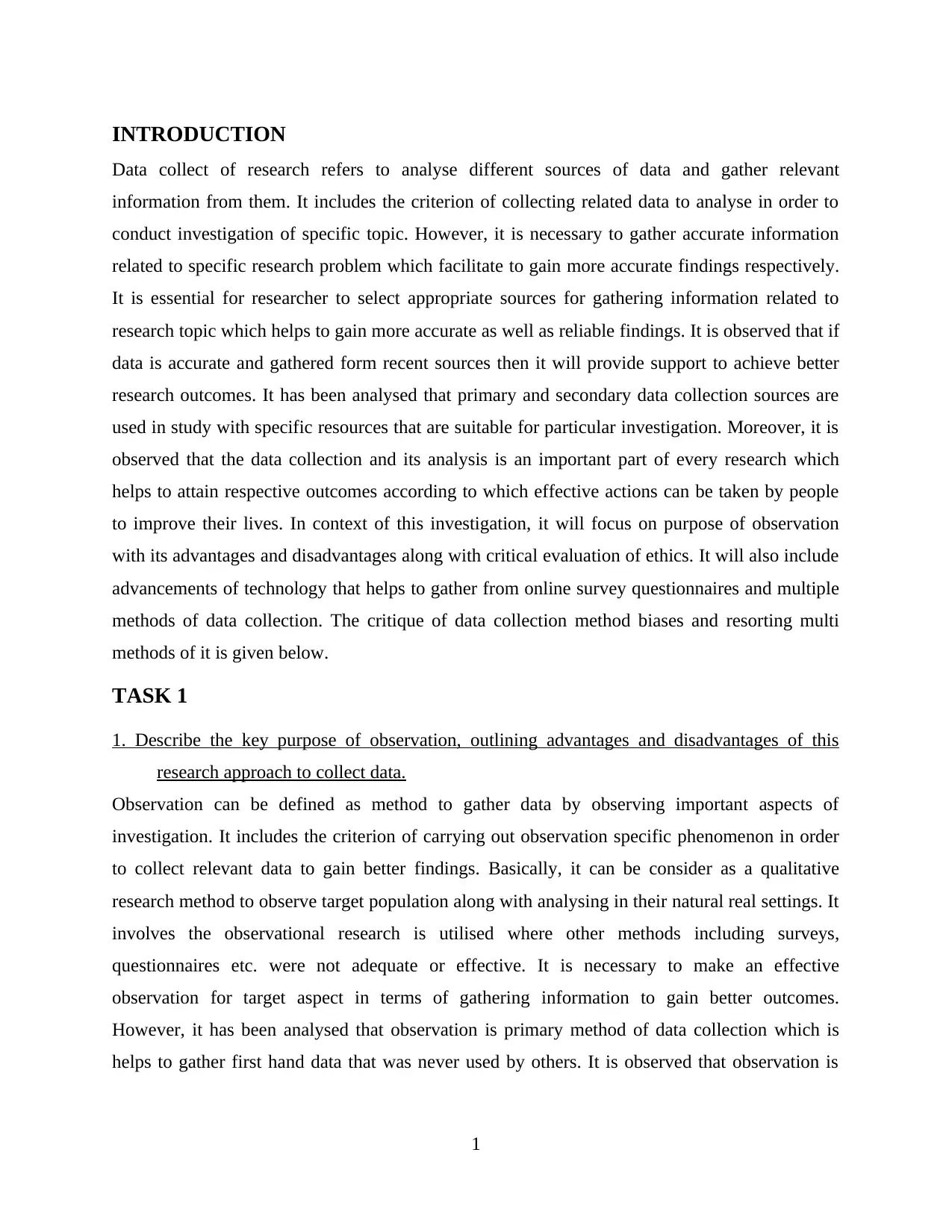
INTRODUCTION
Data collect of research refers to analyse different sources of data and gather relevant
information from them. It includes the criterion of collecting related data to analyse in order to
conduct investigation of specific topic. However, it is necessary to gather accurate information
related to specific research problem which facilitate to gain more accurate findings respectively.
It is essential for researcher to select appropriate sources for gathering information related to
research topic which helps to gain more accurate as well as reliable findings. It is observed that if
data is accurate and gathered form recent sources then it will provide support to achieve better
research outcomes. It has been analysed that primary and secondary data collection sources are
used in study with specific resources that are suitable for particular investigation. Moreover, it is
observed that the data collection and its analysis is an important part of every research which
helps to attain respective outcomes according to which effective actions can be taken by people
to improve their lives. In context of this investigation, it will focus on purpose of observation
with its advantages and disadvantages along with critical evaluation of ethics. It will also include
advancements of technology that helps to gather from online survey questionnaires and multiple
methods of data collection. The critique of data collection method biases and resorting multi
methods of it is given below.
TASK 1
1. Describe the key purpose of observation, outlining advantages and disadvantages of this
research approach to collect data.
Observation can be defined as method to gather data by observing important aspects of
investigation. It includes the criterion of carrying out observation specific phenomenon in order
to collect relevant data to gain better findings. Basically, it can be consider as a qualitative
research method to observe target population along with analysing in their natural real settings. It
involves the observational research is utilised where other methods including surveys,
questionnaires etc. were not adequate or effective. It is necessary to make an effective
observation for target aspect in terms of gathering information to gain better outcomes.
However, it has been analysed that observation is primary method of data collection which is
helps to gather first hand data that was never used by others. It is observed that observation is
1
Data collect of research refers to analyse different sources of data and gather relevant
information from them. It includes the criterion of collecting related data to analyse in order to
conduct investigation of specific topic. However, it is necessary to gather accurate information
related to specific research problem which facilitate to gain more accurate findings respectively.
It is essential for researcher to select appropriate sources for gathering information related to
research topic which helps to gain more accurate as well as reliable findings. It is observed that if
data is accurate and gathered form recent sources then it will provide support to achieve better
research outcomes. It has been analysed that primary and secondary data collection sources are
used in study with specific resources that are suitable for particular investigation. Moreover, it is
observed that the data collection and its analysis is an important part of every research which
helps to attain respective outcomes according to which effective actions can be taken by people
to improve their lives. In context of this investigation, it will focus on purpose of observation
with its advantages and disadvantages along with critical evaluation of ethics. It will also include
advancements of technology that helps to gather from online survey questionnaires and multiple
methods of data collection. The critique of data collection method biases and resorting multi
methods of it is given below.
TASK 1
1. Describe the key purpose of observation, outlining advantages and disadvantages of this
research approach to collect data.
Observation can be defined as method to gather data by observing important aspects of
investigation. It includes the criterion of carrying out observation specific phenomenon in order
to collect relevant data to gain better findings. Basically, it can be consider as a qualitative
research method to observe target population along with analysing in their natural real settings. It
involves the observational research is utilised where other methods including surveys,
questionnaires etc. were not adequate or effective. It is necessary to make an effective
observation for target aspect in terms of gathering information to gain better outcomes.
However, it has been analysed that observation is primary method of data collection which is
helps to gather first hand data that was never used by others. It is observed that observation is
1
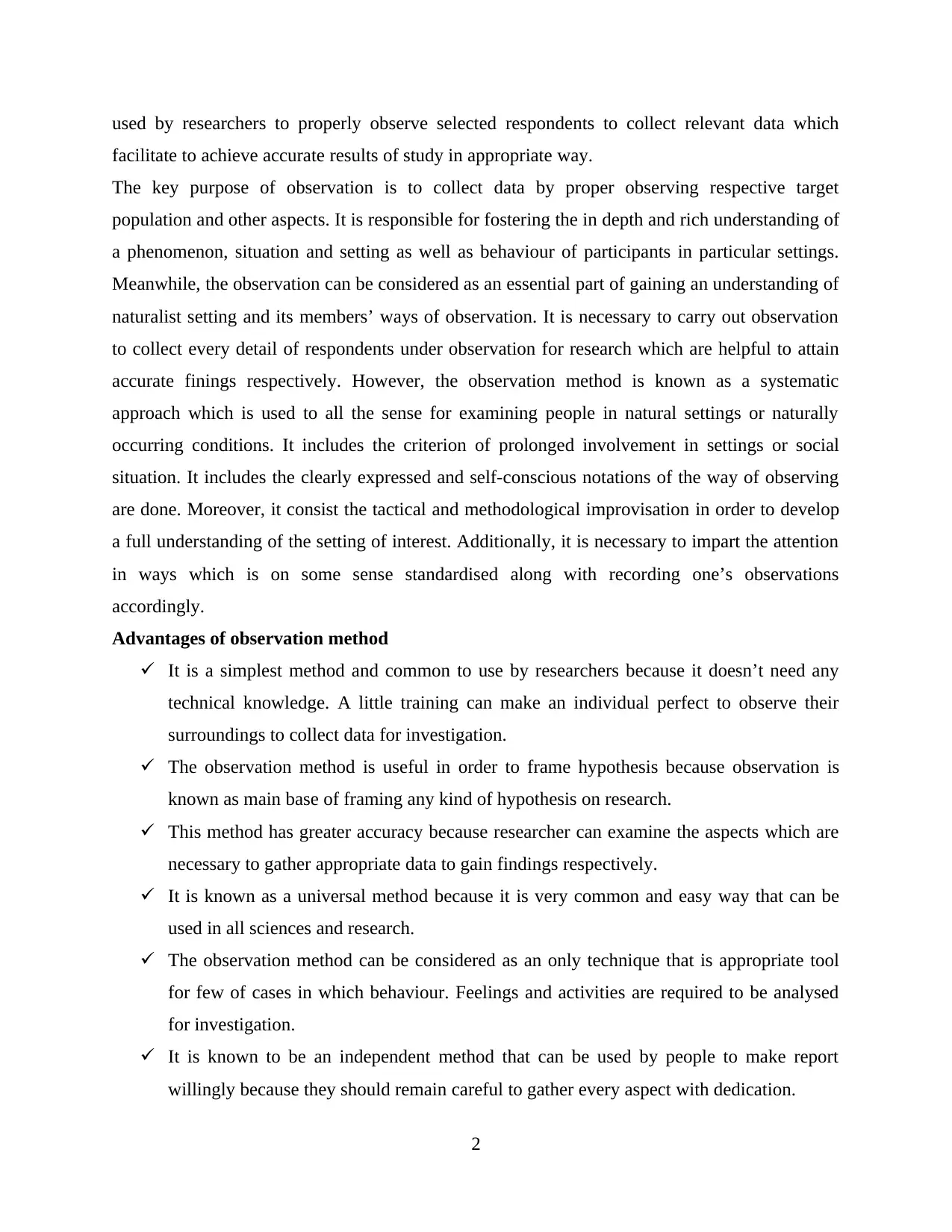
used by researchers to properly observe selected respondents to collect relevant data which
facilitate to achieve accurate results of study in appropriate way.
The key purpose of observation is to collect data by proper observing respective target
population and other aspects. It is responsible for fostering the in depth and rich understanding of
a phenomenon, situation and setting as well as behaviour of participants in particular settings.
Meanwhile, the observation can be considered as an essential part of gaining an understanding of
naturalist setting and its members’ ways of observation. It is necessary to carry out observation
to collect every detail of respondents under observation for research which are helpful to attain
accurate finings respectively. However, the observation method is known as a systematic
approach which is used to all the sense for examining people in natural settings or naturally
occurring conditions. It includes the criterion of prolonged involvement in settings or social
situation. It includes the clearly expressed and self-conscious notations of the way of observing
are done. Moreover, it consist the tactical and methodological improvisation in order to develop
a full understanding of the setting of interest. Additionally, it is necessary to impart the attention
in ways which is on some sense standardised along with recording one’s observations
accordingly.
Advantages of observation method
It is a simplest method and common to use by researchers because it doesn’t need any
technical knowledge. A little training can make an individual perfect to observe their
surroundings to collect data for investigation.
The observation method is useful in order to frame hypothesis because observation is
known as main base of framing any kind of hypothesis on research.
This method has greater accuracy because researcher can examine the aspects which are
necessary to gather appropriate data to gain findings respectively.
It is known as a universal method because it is very common and easy way that can be
used in all sciences and research.
The observation method can be considered as an only technique that is appropriate tool
for few of cases in which behaviour. Feelings and activities are required to be analysed
for investigation.
It is known to be an independent method that can be used by people to make report
willingly because they should remain careful to gather every aspect with dedication.
2
facilitate to achieve accurate results of study in appropriate way.
The key purpose of observation is to collect data by proper observing respective target
population and other aspects. It is responsible for fostering the in depth and rich understanding of
a phenomenon, situation and setting as well as behaviour of participants in particular settings.
Meanwhile, the observation can be considered as an essential part of gaining an understanding of
naturalist setting and its members’ ways of observation. It is necessary to carry out observation
to collect every detail of respondents under observation for research which are helpful to attain
accurate finings respectively. However, the observation method is known as a systematic
approach which is used to all the sense for examining people in natural settings or naturally
occurring conditions. It includes the criterion of prolonged involvement in settings or social
situation. It includes the clearly expressed and self-conscious notations of the way of observing
are done. Moreover, it consist the tactical and methodological improvisation in order to develop
a full understanding of the setting of interest. Additionally, it is necessary to impart the attention
in ways which is on some sense standardised along with recording one’s observations
accordingly.
Advantages of observation method
It is a simplest method and common to use by researchers because it doesn’t need any
technical knowledge. A little training can make an individual perfect to observe their
surroundings to collect data for investigation.
The observation method is useful in order to frame hypothesis because observation is
known as main base of framing any kind of hypothesis on research.
This method has greater accuracy because researcher can examine the aspects which are
necessary to gather appropriate data to gain findings respectively.
It is known as a universal method because it is very common and easy way that can be
used in all sciences and research.
The observation method can be considered as an only technique that is appropriate tool
for few of cases in which behaviour. Feelings and activities are required to be analysed
for investigation.
It is known to be an independent method that can be used by people to make report
willingly because they should remain careful to gather every aspect with dedication.
2
Secure Best Marks with AI Grader
Need help grading? Try our AI Grader for instant feedback on your assignments.
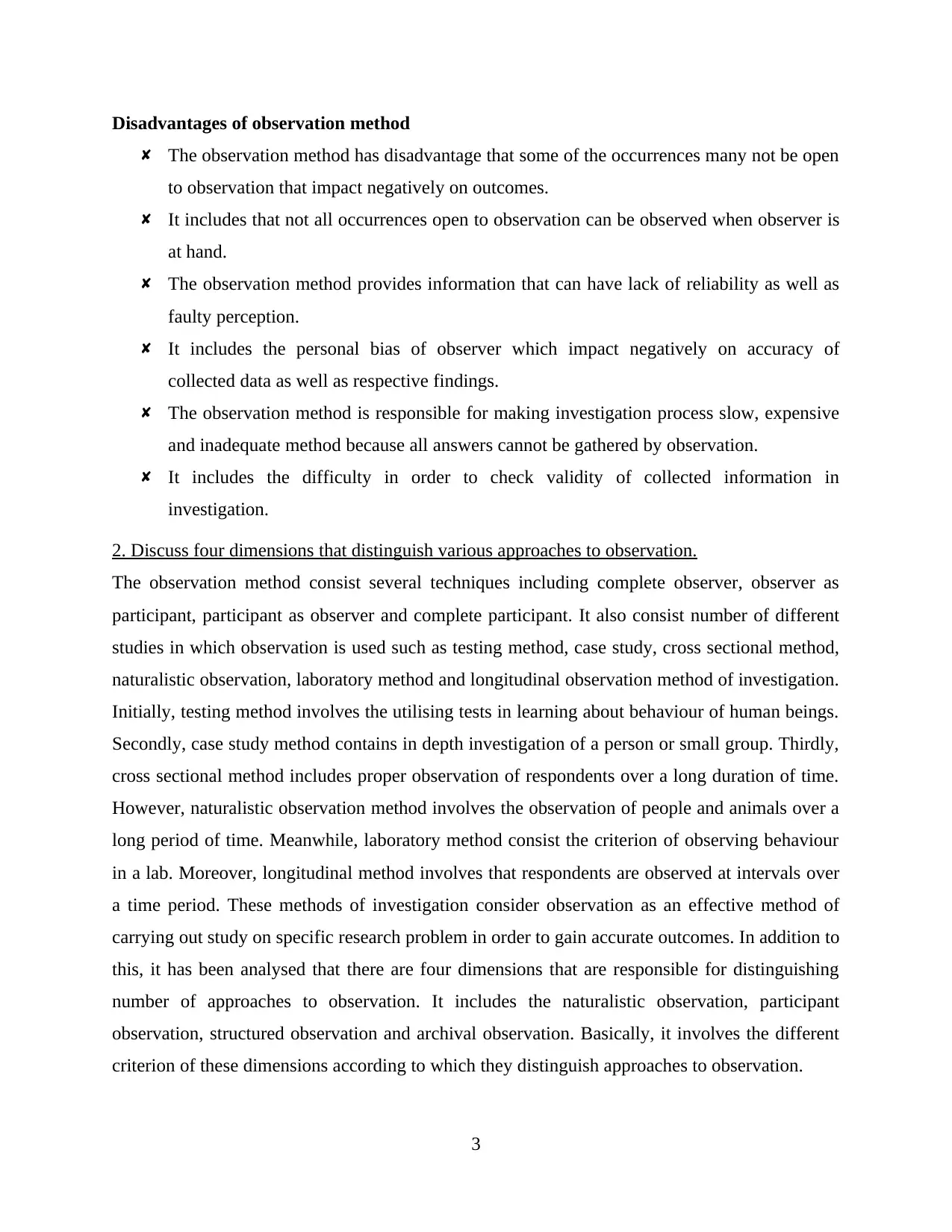
Disadvantages of observation method
The observation method has disadvantage that some of the occurrences many not be open
to observation that impact negatively on outcomes.
It includes that not all occurrences open to observation can be observed when observer is
at hand.
The observation method provides information that can have lack of reliability as well as
faulty perception.
It includes the personal bias of observer which impact negatively on accuracy of
collected data as well as respective findings.
The observation method is responsible for making investigation process slow, expensive
and inadequate method because all answers cannot be gathered by observation.
It includes the difficulty in order to check validity of collected information in
investigation.
2. Discuss four dimensions that distinguish various approaches to observation.
The observation method consist several techniques including complete observer, observer as
participant, participant as observer and complete participant. It also consist number of different
studies in which observation is used such as testing method, case study, cross sectional method,
naturalistic observation, laboratory method and longitudinal observation method of investigation.
Initially, testing method involves the utilising tests in learning about behaviour of human beings.
Secondly, case study method contains in depth investigation of a person or small group. Thirdly,
cross sectional method includes proper observation of respondents over a long duration of time.
However, naturalistic observation method involves the observation of people and animals over a
long period of time. Meanwhile, laboratory method consist the criterion of observing behaviour
in a lab. Moreover, longitudinal method involves that respondents are observed at intervals over
a time period. These methods of investigation consider observation as an effective method of
carrying out study on specific research problem in order to gain accurate outcomes. In addition to
this, it has been analysed that there are four dimensions that are responsible for distinguishing
number of approaches to observation. It includes the naturalistic observation, participant
observation, structured observation and archival observation. Basically, it involves the different
criterion of these dimensions according to which they distinguish approaches to observation.
3
The observation method has disadvantage that some of the occurrences many not be open
to observation that impact negatively on outcomes.
It includes that not all occurrences open to observation can be observed when observer is
at hand.
The observation method provides information that can have lack of reliability as well as
faulty perception.
It includes the personal bias of observer which impact negatively on accuracy of
collected data as well as respective findings.
The observation method is responsible for making investigation process slow, expensive
and inadequate method because all answers cannot be gathered by observation.
It includes the difficulty in order to check validity of collected information in
investigation.
2. Discuss four dimensions that distinguish various approaches to observation.
The observation method consist several techniques including complete observer, observer as
participant, participant as observer and complete participant. It also consist number of different
studies in which observation is used such as testing method, case study, cross sectional method,
naturalistic observation, laboratory method and longitudinal observation method of investigation.
Initially, testing method involves the utilising tests in learning about behaviour of human beings.
Secondly, case study method contains in depth investigation of a person or small group. Thirdly,
cross sectional method includes proper observation of respondents over a long duration of time.
However, naturalistic observation method involves the observation of people and animals over a
long period of time. Meanwhile, laboratory method consist the criterion of observing behaviour
in a lab. Moreover, longitudinal method involves that respondents are observed at intervals over
a time period. These methods of investigation consider observation as an effective method of
carrying out study on specific research problem in order to gain accurate outcomes. In addition to
this, it has been analysed that there are four dimensions that are responsible for distinguishing
number of approaches to observation. It includes the naturalistic observation, participant
observation, structured observation and archival observation. Basically, it involves the different
criterion of these dimensions according to which they distinguish approaches to observation.
3
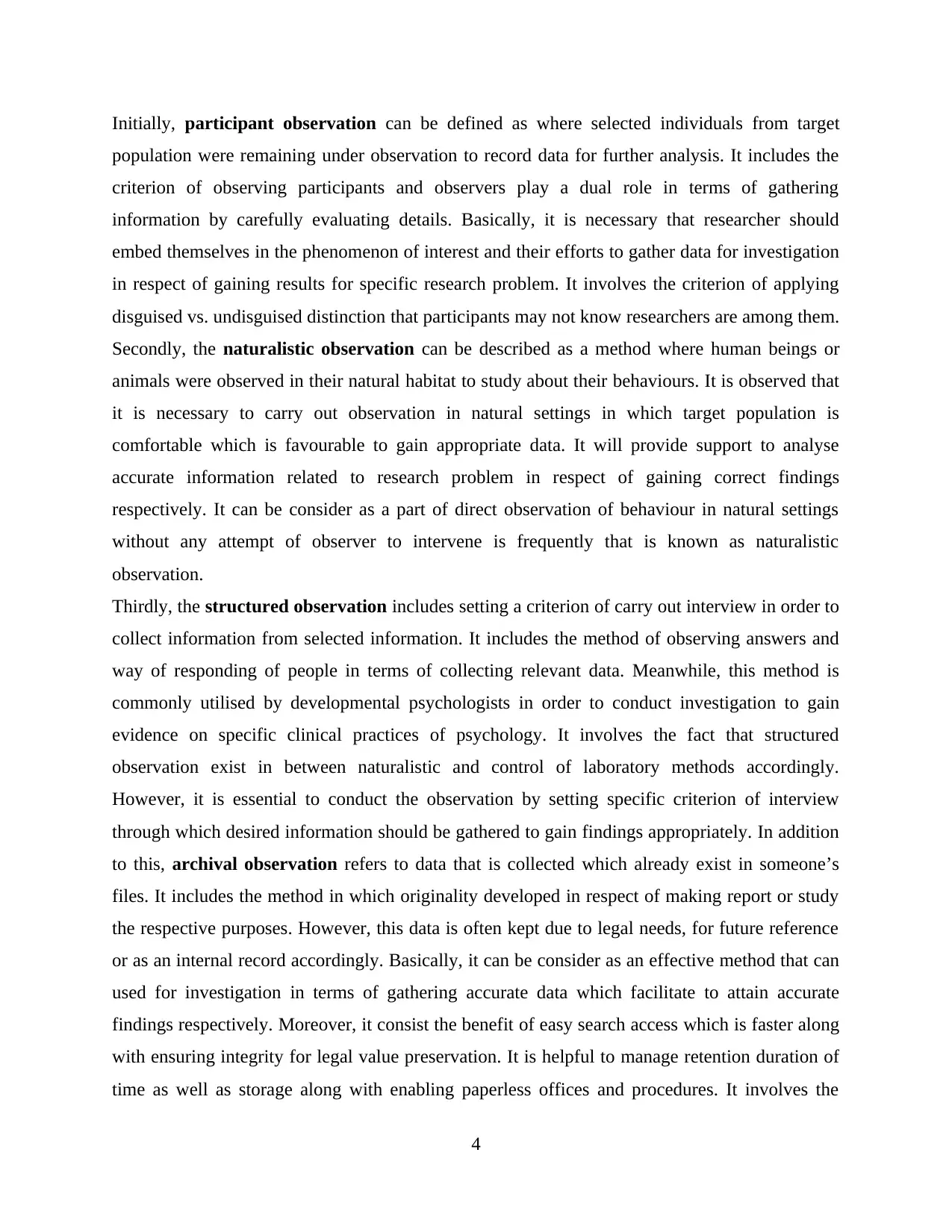
Initially, participant observation can be defined as where selected individuals from target
population were remaining under observation to record data for further analysis. It includes the
criterion of observing participants and observers play a dual role in terms of gathering
information by carefully evaluating details. Basically, it is necessary that researcher should
embed themselves in the phenomenon of interest and their efforts to gather data for investigation
in respect of gaining results for specific research problem. It involves the criterion of applying
disguised vs. undisguised distinction that participants may not know researchers are among them.
Secondly, the naturalistic observation can be described as a method where human beings or
animals were observed in their natural habitat to study about their behaviours. It is observed that
it is necessary to carry out observation in natural settings in which target population is
comfortable which is favourable to gain appropriate data. It will provide support to analyse
accurate information related to research problem in respect of gaining correct findings
respectively. It can be consider as a part of direct observation of behaviour in natural settings
without any attempt of observer to intervene is frequently that is known as naturalistic
observation.
Thirdly, the structured observation includes setting a criterion of carry out interview in order to
collect information from selected information. It includes the method of observing answers and
way of responding of people in terms of collecting relevant data. Meanwhile, this method is
commonly utilised by developmental psychologists in order to conduct investigation to gain
evidence on specific clinical practices of psychology. It involves the fact that structured
observation exist in between naturalistic and control of laboratory methods accordingly.
However, it is essential to conduct the observation by setting specific criterion of interview
through which desired information should be gathered to gain findings appropriately. In addition
to this, archival observation refers to data that is collected which already exist in someone’s
files. It includes the method in which originality developed in respect of making report or study
the respective purposes. However, this data is often kept due to legal needs, for future reference
or as an internal record accordingly. Basically, it can be consider as an effective method that can
used for investigation in terms of gathering accurate data which facilitate to attain accurate
findings respectively. Moreover, it consist the benefit of easy search access which is faster along
with ensuring integrity for legal value preservation. It is helpful to manage retention duration of
time as well as storage along with enabling paperless offices and procedures. It involves the
4
population were remaining under observation to record data for further analysis. It includes the
criterion of observing participants and observers play a dual role in terms of gathering
information by carefully evaluating details. Basically, it is necessary that researcher should
embed themselves in the phenomenon of interest and their efforts to gather data for investigation
in respect of gaining results for specific research problem. It involves the criterion of applying
disguised vs. undisguised distinction that participants may not know researchers are among them.
Secondly, the naturalistic observation can be described as a method where human beings or
animals were observed in their natural habitat to study about their behaviours. It is observed that
it is necessary to carry out observation in natural settings in which target population is
comfortable which is favourable to gain appropriate data. It will provide support to analyse
accurate information related to research problem in respect of gaining correct findings
respectively. It can be consider as a part of direct observation of behaviour in natural settings
without any attempt of observer to intervene is frequently that is known as naturalistic
observation.
Thirdly, the structured observation includes setting a criterion of carry out interview in order to
collect information from selected information. It includes the method of observing answers and
way of responding of people in terms of collecting relevant data. Meanwhile, this method is
commonly utilised by developmental psychologists in order to conduct investigation to gain
evidence on specific clinical practices of psychology. It involves the fact that structured
observation exist in between naturalistic and control of laboratory methods accordingly.
However, it is essential to conduct the observation by setting specific criterion of interview
through which desired information should be gathered to gain findings appropriately. In addition
to this, archival observation refers to data that is collected which already exist in someone’s
files. It includes the method in which originality developed in respect of making report or study
the respective purposes. However, this data is often kept due to legal needs, for future reference
or as an internal record accordingly. Basically, it can be consider as an effective method that can
used for investigation in terms of gathering accurate data which facilitate to attain accurate
findings respectively. Moreover, it consist the benefit of easy search access which is faster along
with ensuring integrity for legal value preservation. It is helpful to manage retention duration of
time as well as storage along with enabling paperless offices and procedures. It involves the
4
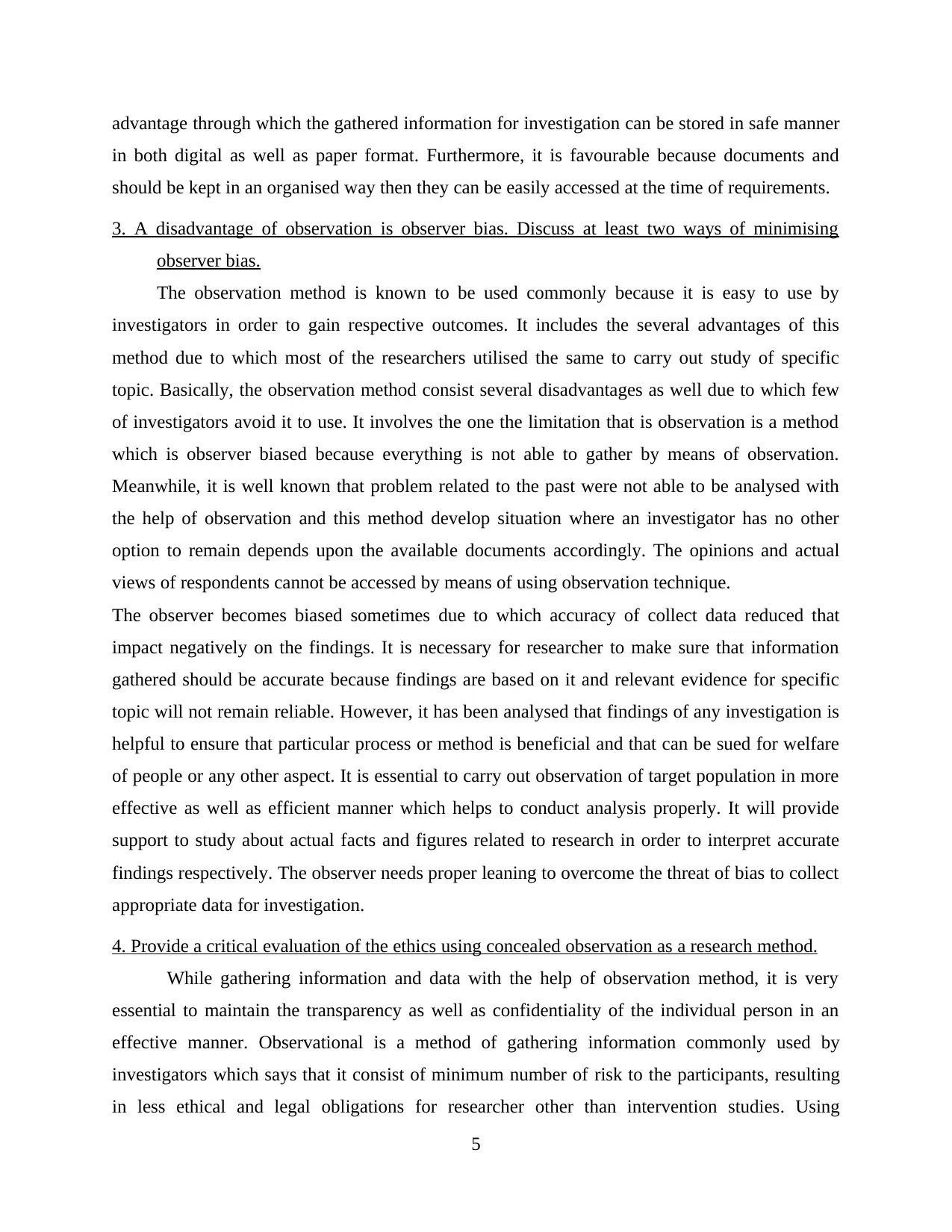
advantage through which the gathered information for investigation can be stored in safe manner
in both digital as well as paper format. Furthermore, it is favourable because documents and
should be kept in an organised way then they can be easily accessed at the time of requirements.
3. A disadvantage of observation is observer bias. Discuss at least two ways of minimising
observer bias.
The observation method is known to be used commonly because it is easy to use by
investigators in order to gain respective outcomes. It includes the several advantages of this
method due to which most of the researchers utilised the same to carry out study of specific
topic. Basically, the observation method consist several disadvantages as well due to which few
of investigators avoid it to use. It involves the one the limitation that is observation is a method
which is observer biased because everything is not able to gather by means of observation.
Meanwhile, it is well known that problem related to the past were not able to be analysed with
the help of observation and this method develop situation where an investigator has no other
option to remain depends upon the available documents accordingly. The opinions and actual
views of respondents cannot be accessed by means of using observation technique.
The observer becomes biased sometimes due to which accuracy of collect data reduced that
impact negatively on the findings. It is necessary for researcher to make sure that information
gathered should be accurate because findings are based on it and relevant evidence for specific
topic will not remain reliable. However, it has been analysed that findings of any investigation is
helpful to ensure that particular process or method is beneficial and that can be sued for welfare
of people or any other aspect. It is essential to carry out observation of target population in more
effective as well as efficient manner which helps to conduct analysis properly. It will provide
support to study about actual facts and figures related to research in order to interpret accurate
findings respectively. The observer needs proper leaning to overcome the threat of bias to collect
appropriate data for investigation.
4. Provide a critical evaluation of the ethics using concealed observation as a research method.
While gathering information and data with the help of observation method, it is very
essential to maintain the transparency as well as confidentiality of the individual person in an
effective manner. Observational is a method of gathering information commonly used by
investigators which says that it consist of minimum number of risk to the participants, resulting
in less ethical and legal obligations for researcher other than intervention studies. Using
5
in both digital as well as paper format. Furthermore, it is favourable because documents and
should be kept in an organised way then they can be easily accessed at the time of requirements.
3. A disadvantage of observation is observer bias. Discuss at least two ways of minimising
observer bias.
The observation method is known to be used commonly because it is easy to use by
investigators in order to gain respective outcomes. It includes the several advantages of this
method due to which most of the researchers utilised the same to carry out study of specific
topic. Basically, the observation method consist several disadvantages as well due to which few
of investigators avoid it to use. It involves the one the limitation that is observation is a method
which is observer biased because everything is not able to gather by means of observation.
Meanwhile, it is well known that problem related to the past were not able to be analysed with
the help of observation and this method develop situation where an investigator has no other
option to remain depends upon the available documents accordingly. The opinions and actual
views of respondents cannot be accessed by means of using observation technique.
The observer becomes biased sometimes due to which accuracy of collect data reduced that
impact negatively on the findings. It is necessary for researcher to make sure that information
gathered should be accurate because findings are based on it and relevant evidence for specific
topic will not remain reliable. However, it has been analysed that findings of any investigation is
helpful to ensure that particular process or method is beneficial and that can be sued for welfare
of people or any other aspect. It is essential to carry out observation of target population in more
effective as well as efficient manner which helps to conduct analysis properly. It will provide
support to study about actual facts and figures related to research in order to interpret accurate
findings respectively. The observer needs proper leaning to overcome the threat of bias to collect
appropriate data for investigation.
4. Provide a critical evaluation of the ethics using concealed observation as a research method.
While gathering information and data with the help of observation method, it is very
essential to maintain the transparency as well as confidentiality of the individual person in an
effective manner. Observational is a method of gathering information commonly used by
investigators which says that it consist of minimum number of risk to the participants, resulting
in less ethical and legal obligations for researcher other than intervention studies. Using
5
Paraphrase This Document
Need a fresh take? Get an instant paraphrase of this document with our AI Paraphraser
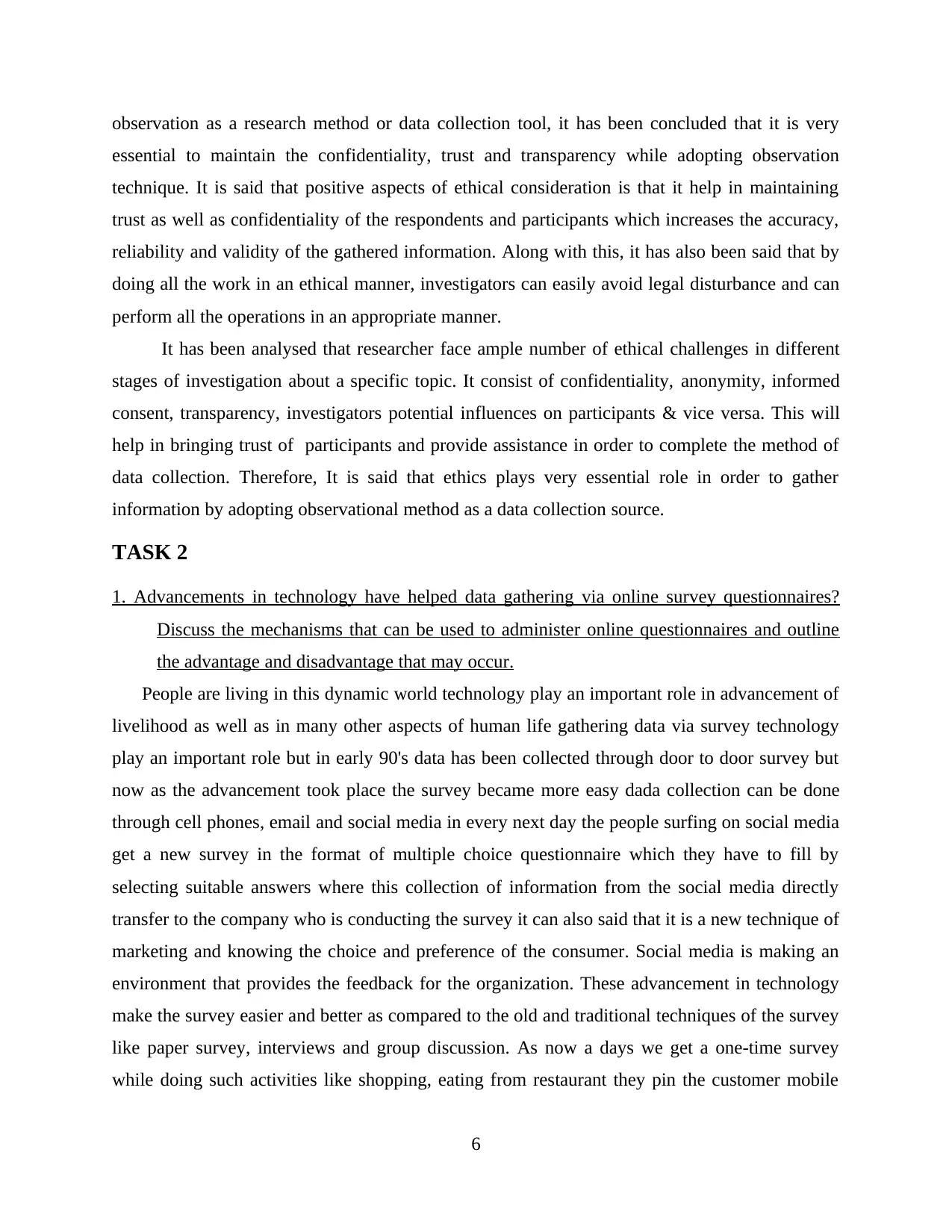
observation as a research method or data collection tool, it has been concluded that it is very
essential to maintain the confidentiality, trust and transparency while adopting observation
technique. It is said that positive aspects of ethical consideration is that it help in maintaining
trust as well as confidentiality of the respondents and participants which increases the accuracy,
reliability and validity of the gathered information. Along with this, it has also been said that by
doing all the work in an ethical manner, investigators can easily avoid legal disturbance and can
perform all the operations in an appropriate manner.
It has been analysed that researcher face ample number of ethical challenges in different
stages of investigation about a specific topic. It consist of confidentiality, anonymity, informed
consent, transparency, investigators potential influences on participants & vice versa. This will
help in bringing trust of participants and provide assistance in order to complete the method of
data collection. Therefore, It is said that ethics plays very essential role in order to gather
information by adopting observational method as a data collection source.
TASK 2
1. Advancements in technology have helped data gathering via online survey questionnaires?
Discuss the mechanisms that can be used to administer online questionnaires and outline
the advantage and disadvantage that may occur.
People are living in this dynamic world technology play an important role in advancement of
livelihood as well as in many other aspects of human life gathering data via survey technology
play an important role but in early 90's data has been collected through door to door survey but
now as the advancement took place the survey became more easy dada collection can be done
through cell phones, email and social media in every next day the people surfing on social media
get a new survey in the format of multiple choice questionnaire which they have to fill by
selecting suitable answers where this collection of information from the social media directly
transfer to the company who is conducting the survey it can also said that it is a new technique of
marketing and knowing the choice and preference of the consumer. Social media is making an
environment that provides the feedback for the organization. These advancement in technology
make the survey easier and better as compared to the old and traditional techniques of the survey
like paper survey, interviews and group discussion. As now a days we get a one-time survey
while doing such activities like shopping, eating from restaurant they pin the customer mobile
6
essential to maintain the confidentiality, trust and transparency while adopting observation
technique. It is said that positive aspects of ethical consideration is that it help in maintaining
trust as well as confidentiality of the respondents and participants which increases the accuracy,
reliability and validity of the gathered information. Along with this, it has also been said that by
doing all the work in an ethical manner, investigators can easily avoid legal disturbance and can
perform all the operations in an appropriate manner.
It has been analysed that researcher face ample number of ethical challenges in different
stages of investigation about a specific topic. It consist of confidentiality, anonymity, informed
consent, transparency, investigators potential influences on participants & vice versa. This will
help in bringing trust of participants and provide assistance in order to complete the method of
data collection. Therefore, It is said that ethics plays very essential role in order to gather
information by adopting observational method as a data collection source.
TASK 2
1. Advancements in technology have helped data gathering via online survey questionnaires?
Discuss the mechanisms that can be used to administer online questionnaires and outline
the advantage and disadvantage that may occur.
People are living in this dynamic world technology play an important role in advancement of
livelihood as well as in many other aspects of human life gathering data via survey technology
play an important role but in early 90's data has been collected through door to door survey but
now as the advancement took place the survey became more easy dada collection can be done
through cell phones, email and social media in every next day the people surfing on social media
get a new survey in the format of multiple choice questionnaire which they have to fill by
selecting suitable answers where this collection of information from the social media directly
transfer to the company who is conducting the survey it can also said that it is a new technique of
marketing and knowing the choice and preference of the consumer. Social media is making an
environment that provides the feedback for the organization. These advancement in technology
make the survey easier and better as compared to the old and traditional techniques of the survey
like paper survey, interviews and group discussion. As now a days we get a one-time survey
while doing such activities like shopping, eating from restaurant they pin the customer mobile
6
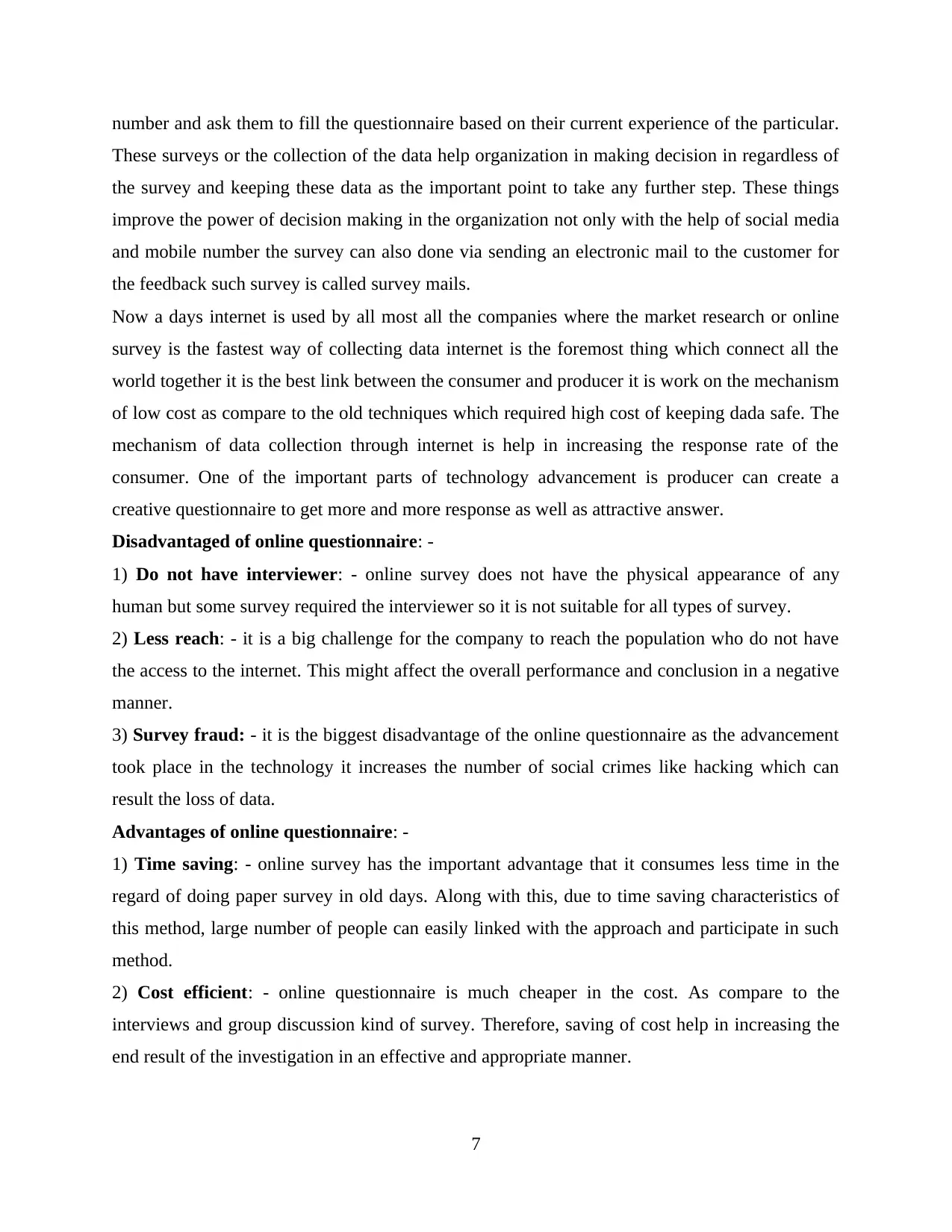
number and ask them to fill the questionnaire based on their current experience of the particular.
These surveys or the collection of the data help organization in making decision in regardless of
the survey and keeping these data as the important point to take any further step. These things
improve the power of decision making in the organization not only with the help of social media
and mobile number the survey can also done via sending an electronic mail to the customer for
the feedback such survey is called survey mails.
Now a days internet is used by all most all the companies where the market research or online
survey is the fastest way of collecting data internet is the foremost thing which connect all the
world together it is the best link between the consumer and producer it is work on the mechanism
of low cost as compare to the old techniques which required high cost of keeping dada safe. The
mechanism of data collection through internet is help in increasing the response rate of the
consumer. One of the important parts of technology advancement is producer can create a
creative questionnaire to get more and more response as well as attractive answer.
Disadvantaged of online questionnaire: -
1) Do not have interviewer: - online survey does not have the physical appearance of any
human but some survey required the interviewer so it is not suitable for all types of survey.
2) Less reach: - it is a big challenge for the company to reach the population who do not have
the access to the internet. This might affect the overall performance and conclusion in a negative
manner.
3) Survey fraud: - it is the biggest disadvantage of the online questionnaire as the advancement
took place in the technology it increases the number of social crimes like hacking which can
result the loss of data.
Advantages of online questionnaire: -
1) Time saving: - online survey has the important advantage that it consumes less time in the
regard of doing paper survey in old days. Along with this, due to time saving characteristics of
this method, large number of people can easily linked with the approach and participate in such
method.
2) Cost efficient: - online questionnaire is much cheaper in the cost. As compare to the
interviews and group discussion kind of survey. Therefore, saving of cost help in increasing the
end result of the investigation in an effective and appropriate manner.
7
These surveys or the collection of the data help organization in making decision in regardless of
the survey and keeping these data as the important point to take any further step. These things
improve the power of decision making in the organization not only with the help of social media
and mobile number the survey can also done via sending an electronic mail to the customer for
the feedback such survey is called survey mails.
Now a days internet is used by all most all the companies where the market research or online
survey is the fastest way of collecting data internet is the foremost thing which connect all the
world together it is the best link between the consumer and producer it is work on the mechanism
of low cost as compare to the old techniques which required high cost of keeping dada safe. The
mechanism of data collection through internet is help in increasing the response rate of the
consumer. One of the important parts of technology advancement is producer can create a
creative questionnaire to get more and more response as well as attractive answer.
Disadvantaged of online questionnaire: -
1) Do not have interviewer: - online survey does not have the physical appearance of any
human but some survey required the interviewer so it is not suitable for all types of survey.
2) Less reach: - it is a big challenge for the company to reach the population who do not have
the access to the internet. This might affect the overall performance and conclusion in a negative
manner.
3) Survey fraud: - it is the biggest disadvantage of the online questionnaire as the advancement
took place in the technology it increases the number of social crimes like hacking which can
result the loss of data.
Advantages of online questionnaire: -
1) Time saving: - online survey has the important advantage that it consumes less time in the
regard of doing paper survey in old days. Along with this, due to time saving characteristics of
this method, large number of people can easily linked with the approach and participate in such
method.
2) Cost efficient: - online questionnaire is much cheaper in the cost. As compare to the
interviews and group discussion kind of survey. Therefore, saving of cost help in increasing the
end result of the investigation in an effective and appropriate manner.
7
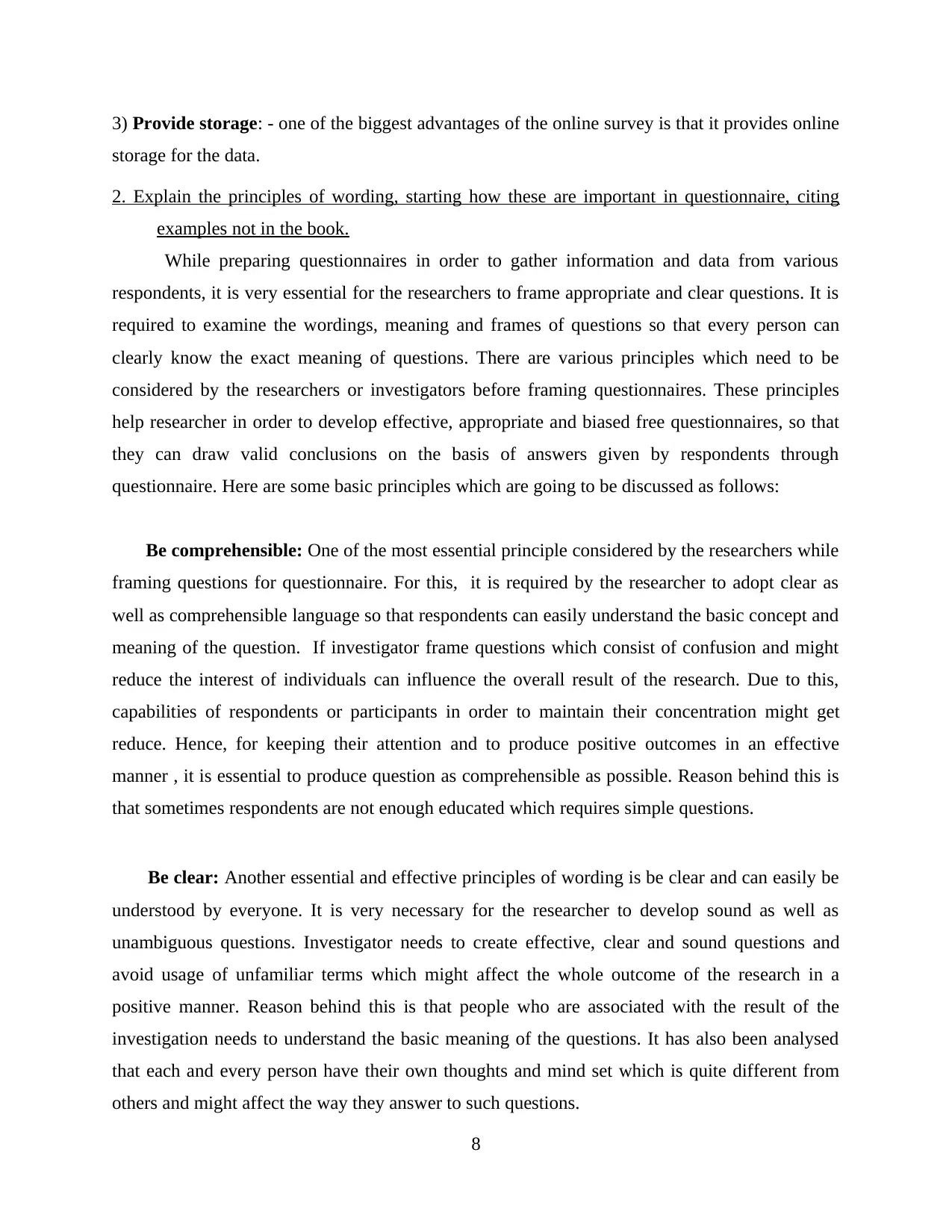
3) Provide storage: - one of the biggest advantages of the online survey is that it provides online
storage for the data.
2. Explain the principles of wording, starting how these are important in questionnaire, citing
examples not in the book.
While preparing questionnaires in order to gather information and data from various
respondents, it is very essential for the researchers to frame appropriate and clear questions. It is
required to examine the wordings, meaning and frames of questions so that every person can
clearly know the exact meaning of questions. There are various principles which need to be
considered by the researchers or investigators before framing questionnaires. These principles
help researcher in order to develop effective, appropriate and biased free questionnaires, so that
they can draw valid conclusions on the basis of answers given by respondents through
questionnaire. Here are some basic principles which are going to be discussed as follows:
Be comprehensible: One of the most essential principle considered by the researchers while
framing questions for questionnaire. For this, it is required by the researcher to adopt clear as
well as comprehensible language so that respondents can easily understand the basic concept and
meaning of the question. If investigator frame questions which consist of confusion and might
reduce the interest of individuals can influence the overall result of the research. Due to this,
capabilities of respondents or participants in order to maintain their concentration might get
reduce. Hence, for keeping their attention and to produce positive outcomes in an effective
manner , it is essential to produce question as comprehensible as possible. Reason behind this is
that sometimes respondents are not enough educated which requires simple questions.
Be clear: Another essential and effective principles of wording is be clear and can easily be
understood by everyone. It is very necessary for the researcher to develop sound as well as
unambiguous questions. Investigator needs to create effective, clear and sound questions and
avoid usage of unfamiliar terms which might affect the whole outcome of the research in a
positive manner. Reason behind this is that people who are associated with the result of the
investigation needs to understand the basic meaning of the questions. It has also been analysed
that each and every person have their own thoughts and mind set which is quite different from
others and might affect the way they answer to such questions.
8
storage for the data.
2. Explain the principles of wording, starting how these are important in questionnaire, citing
examples not in the book.
While preparing questionnaires in order to gather information and data from various
respondents, it is very essential for the researchers to frame appropriate and clear questions. It is
required to examine the wordings, meaning and frames of questions so that every person can
clearly know the exact meaning of questions. There are various principles which need to be
considered by the researchers or investigators before framing questionnaires. These principles
help researcher in order to develop effective, appropriate and biased free questionnaires, so that
they can draw valid conclusions on the basis of answers given by respondents through
questionnaire. Here are some basic principles which are going to be discussed as follows:
Be comprehensible: One of the most essential principle considered by the researchers while
framing questions for questionnaire. For this, it is required by the researcher to adopt clear as
well as comprehensible language so that respondents can easily understand the basic concept and
meaning of the question. If investigator frame questions which consist of confusion and might
reduce the interest of individuals can influence the overall result of the research. Due to this,
capabilities of respondents or participants in order to maintain their concentration might get
reduce. Hence, for keeping their attention and to produce positive outcomes in an effective
manner , it is essential to produce question as comprehensible as possible. Reason behind this is
that sometimes respondents are not enough educated which requires simple questions.
Be clear: Another essential and effective principles of wording is be clear and can easily be
understood by everyone. It is very necessary for the researcher to develop sound as well as
unambiguous questions. Investigator needs to create effective, clear and sound questions and
avoid usage of unfamiliar terms which might affect the whole outcome of the research in a
positive manner. Reason behind this is that people who are associated with the result of the
investigation needs to understand the basic meaning of the questions. It has also been analysed
that each and every person have their own thoughts and mind set which is quite different from
others and might affect the way they answer to such questions.
8
Secure Best Marks with AI Grader
Need help grading? Try our AI Grader for instant feedback on your assignments.
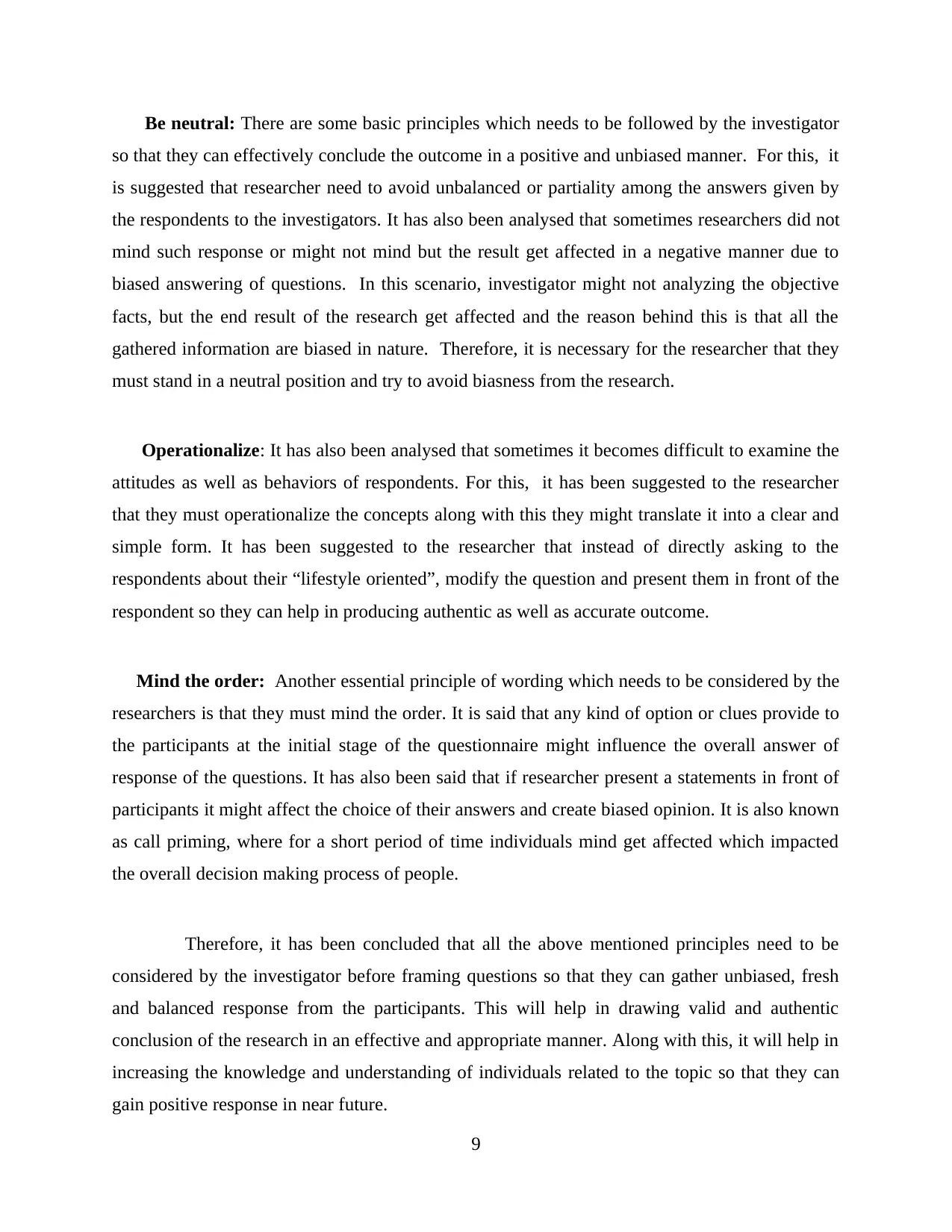
Be neutral: There are some basic principles which needs to be followed by the investigator
so that they can effectively conclude the outcome in a positive and unbiased manner. For this, it
is suggested that researcher need to avoid unbalanced or partiality among the answers given by
the respondents to the investigators. It has also been analysed that sometimes researchers did not
mind such response or might not mind but the result get affected in a negative manner due to
biased answering of questions. In this scenario, investigator might not analyzing the objective
facts, but the end result of the research get affected and the reason behind this is that all the
gathered information are biased in nature. Therefore, it is necessary for the researcher that they
must stand in a neutral position and try to avoid biasness from the research.
Operationalize: It has also been analysed that sometimes it becomes difficult to examine the
attitudes as well as behaviors of respondents. For this, it has been suggested to the researcher
that they must operationalize the concepts along with this they might translate it into a clear and
simple form. It has been suggested to the researcher that instead of directly asking to the
respondents about their “lifestyle oriented”, modify the question and present them in front of the
respondent so they can help in producing authentic as well as accurate outcome.
Mind the order: Another essential principle of wording which needs to be considered by the
researchers is that they must mind the order. It is said that any kind of option or clues provide to
the participants at the initial stage of the questionnaire might influence the overall answer of
response of the questions. It has also been said that if researcher present a statements in front of
participants it might affect the choice of their answers and create biased opinion. It is also known
as call priming, where for a short period of time individuals mind get affected which impacted
the overall decision making process of people.
Therefore, it has been concluded that all the above mentioned principles need to be
considered by the investigator before framing questions so that they can gather unbiased, fresh
and balanced response from the participants. This will help in drawing valid and authentic
conclusion of the research in an effective and appropriate manner. Along with this, it will help in
increasing the knowledge and understanding of individuals related to the topic so that they can
gain positive response in near future.
9
so that they can effectively conclude the outcome in a positive and unbiased manner. For this, it
is suggested that researcher need to avoid unbalanced or partiality among the answers given by
the respondents to the investigators. It has also been analysed that sometimes researchers did not
mind such response or might not mind but the result get affected in a negative manner due to
biased answering of questions. In this scenario, investigator might not analyzing the objective
facts, but the end result of the research get affected and the reason behind this is that all the
gathered information are biased in nature. Therefore, it is necessary for the researcher that they
must stand in a neutral position and try to avoid biasness from the research.
Operationalize: It has also been analysed that sometimes it becomes difficult to examine the
attitudes as well as behaviors of respondents. For this, it has been suggested to the researcher
that they must operationalize the concepts along with this they might translate it into a clear and
simple form. It has been suggested to the researcher that instead of directly asking to the
respondents about their “lifestyle oriented”, modify the question and present them in front of the
respondent so they can help in producing authentic as well as accurate outcome.
Mind the order: Another essential principle of wording which needs to be considered by the
researchers is that they must mind the order. It is said that any kind of option or clues provide to
the participants at the initial stage of the questionnaire might influence the overall answer of
response of the questions. It has also been said that if researcher present a statements in front of
participants it might affect the choice of their answers and create biased opinion. It is also known
as call priming, where for a short period of time individuals mind get affected which impacted
the overall decision making process of people.
Therefore, it has been concluded that all the above mentioned principles need to be
considered by the investigator before framing questions so that they can gather unbiased, fresh
and balanced response from the participants. This will help in drawing valid and authentic
conclusion of the research in an effective and appropriate manner. Along with this, it will help in
increasing the knowledge and understanding of individuals related to the topic so that they can
gain positive response in near future.
9
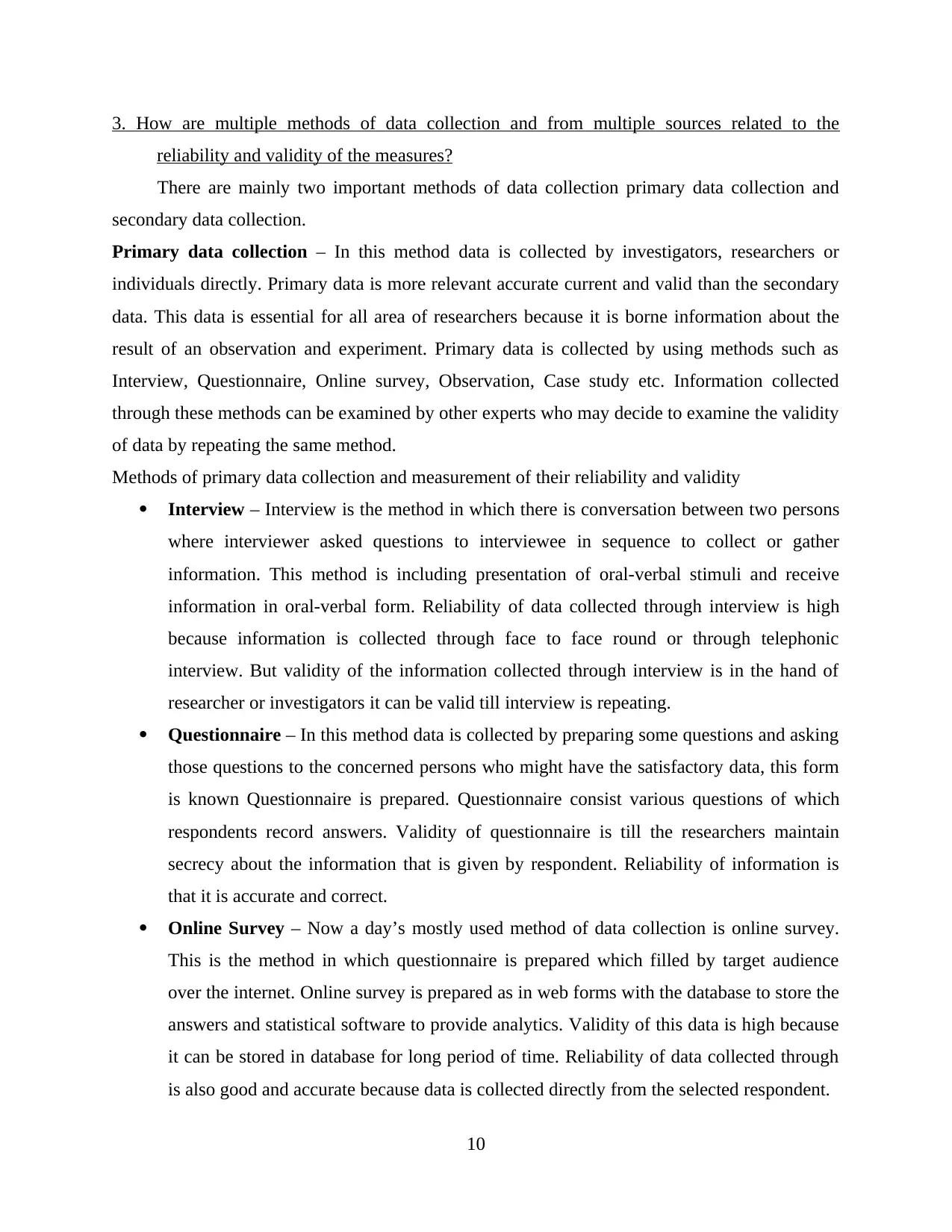
3. How are multiple methods of data collection and from multiple sources related to the
reliability and validity of the measures?
There are mainly two important methods of data collection primary data collection and
secondary data collection.
Primary data collection – In this method data is collected by investigators, researchers or
individuals directly. Primary data is more relevant accurate current and valid than the secondary
data. This data is essential for all area of researchers because it is borne information about the
result of an observation and experiment. Primary data is collected by using methods such as
Interview, Questionnaire, Online survey, Observation, Case study etc. Information collected
through these methods can be examined by other experts who may decide to examine the validity
of data by repeating the same method.
Methods of primary data collection and measurement of their reliability and validity
Interview – Interview is the method in which there is conversation between two persons
where interviewer asked questions to interviewee in sequence to collect or gather
information. This method is including presentation of oral-verbal stimuli and receive
information in oral-verbal form. Reliability of data collected through interview is high
because information is collected through face to face round or through telephonic
interview. But validity of the information collected through interview is in the hand of
researcher or investigators it can be valid till interview is repeating.
Questionnaire – In this method data is collected by preparing some questions and asking
those questions to the concerned persons who might have the satisfactory data, this form
is known Questionnaire is prepared. Questionnaire consist various questions of which
respondents record answers. Validity of questionnaire is till the researchers maintain
secrecy about the information that is given by respondent. Reliability of information is
that it is accurate and correct.
Online Survey – Now a day’s mostly used method of data collection is online survey.
This is the method in which questionnaire is prepared which filled by target audience
over the internet. Online survey is prepared as in web forms with the database to store the
answers and statistical software to provide analytics. Validity of this data is high because
it can be stored in database for long period of time. Reliability of data collected through
is also good and accurate because data is collected directly from the selected respondent.
10
reliability and validity of the measures?
There are mainly two important methods of data collection primary data collection and
secondary data collection.
Primary data collection – In this method data is collected by investigators, researchers or
individuals directly. Primary data is more relevant accurate current and valid than the secondary
data. This data is essential for all area of researchers because it is borne information about the
result of an observation and experiment. Primary data is collected by using methods such as
Interview, Questionnaire, Online survey, Observation, Case study etc. Information collected
through these methods can be examined by other experts who may decide to examine the validity
of data by repeating the same method.
Methods of primary data collection and measurement of their reliability and validity
Interview – Interview is the method in which there is conversation between two persons
where interviewer asked questions to interviewee in sequence to collect or gather
information. This method is including presentation of oral-verbal stimuli and receive
information in oral-verbal form. Reliability of data collected through interview is high
because information is collected through face to face round or through telephonic
interview. But validity of the information collected through interview is in the hand of
researcher or investigators it can be valid till interview is repeating.
Questionnaire – In this method data is collected by preparing some questions and asking
those questions to the concerned persons who might have the satisfactory data, this form
is known Questionnaire is prepared. Questionnaire consist various questions of which
respondents record answers. Validity of questionnaire is till the researchers maintain
secrecy about the information that is given by respondent. Reliability of information is
that it is accurate and correct.
Online Survey – Now a day’s mostly used method of data collection is online survey.
This is the method in which questionnaire is prepared which filled by target audience
over the internet. Online survey is prepared as in web forms with the database to store the
answers and statistical software to provide analytics. Validity of this data is high because
it can be stored in database for long period of time. Reliability of data collected through
is also good and accurate because data is collected directly from the selected respondent.
10
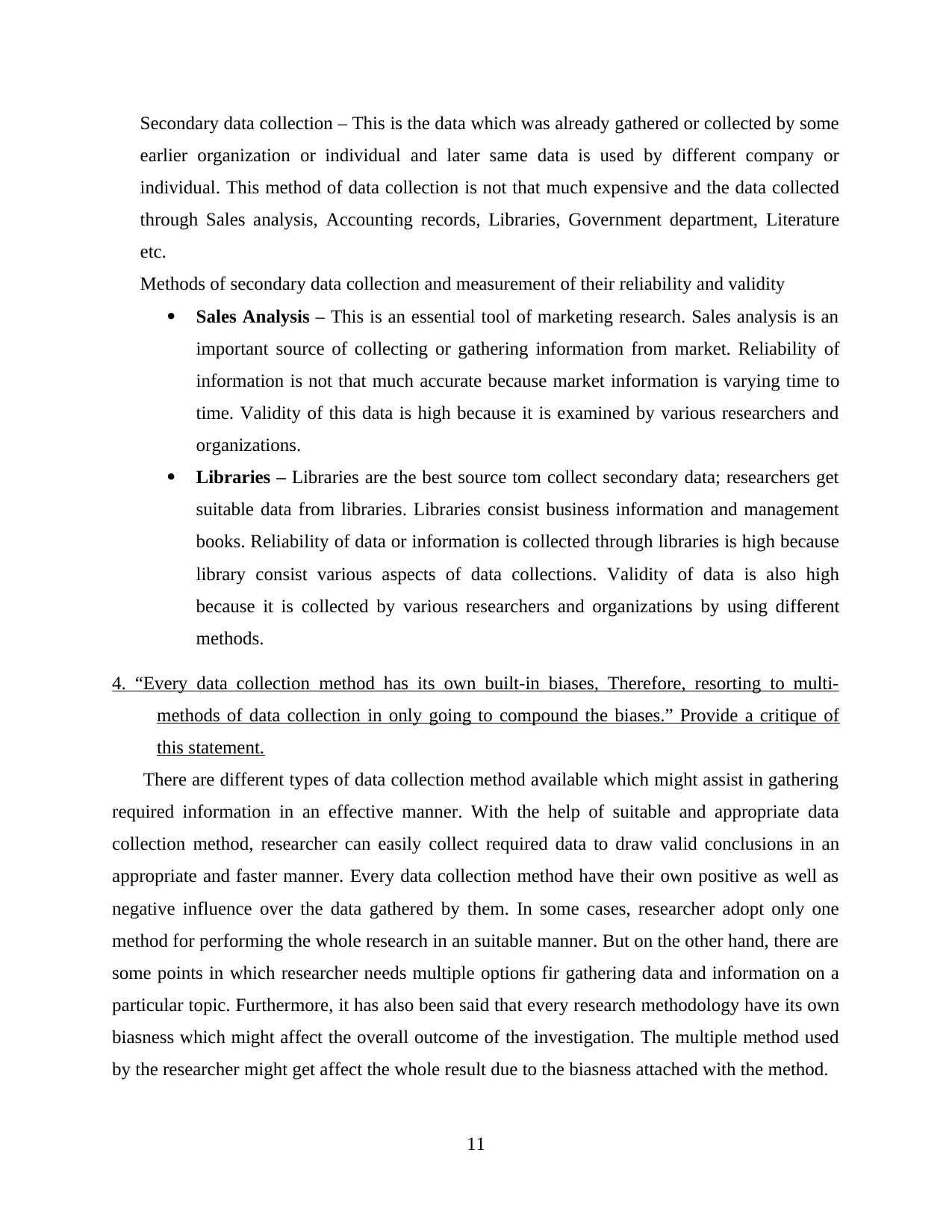
Secondary data collection – This is the data which was already gathered or collected by some
earlier organization or individual and later same data is used by different company or
individual. This method of data collection is not that much expensive and the data collected
through Sales analysis, Accounting records, Libraries, Government department, Literature
etc.
Methods of secondary data collection and measurement of their reliability and validity
Sales Analysis – This is an essential tool of marketing research. Sales analysis is an
important source of collecting or gathering information from market. Reliability of
information is not that much accurate because market information is varying time to
time. Validity of this data is high because it is examined by various researchers and
organizations.
Libraries – Libraries are the best source tom collect secondary data; researchers get
suitable data from libraries. Libraries consist business information and management
books. Reliability of data or information is collected through libraries is high because
library consist various aspects of data collections. Validity of data is also high
because it is collected by various researchers and organizations by using different
methods.
4. “Every data collection method has its own built-in biases, Therefore, resorting to multi-
methods of data collection in only going to compound the biases.” Provide a critique of
this statement.
There are different types of data collection method available which might assist in gathering
required information in an effective manner. With the help of suitable and appropriate data
collection method, researcher can easily collect required data to draw valid conclusions in an
appropriate and faster manner. Every data collection method have their own positive as well as
negative influence over the data gathered by them. In some cases, researcher adopt only one
method for performing the whole research in an suitable manner. But on the other hand, there are
some points in which researcher needs multiple options fir gathering data and information on a
particular topic. Furthermore, it has also been said that every research methodology have its own
biasness which might affect the overall outcome of the investigation. The multiple method used
by the researcher might get affect the whole result due to the biasness attached with the method.
11
earlier organization or individual and later same data is used by different company or
individual. This method of data collection is not that much expensive and the data collected
through Sales analysis, Accounting records, Libraries, Government department, Literature
etc.
Methods of secondary data collection and measurement of their reliability and validity
Sales Analysis – This is an essential tool of marketing research. Sales analysis is an
important source of collecting or gathering information from market. Reliability of
information is not that much accurate because market information is varying time to
time. Validity of this data is high because it is examined by various researchers and
organizations.
Libraries – Libraries are the best source tom collect secondary data; researchers get
suitable data from libraries. Libraries consist business information and management
books. Reliability of data or information is collected through libraries is high because
library consist various aspects of data collections. Validity of data is also high
because it is collected by various researchers and organizations by using different
methods.
4. “Every data collection method has its own built-in biases, Therefore, resorting to multi-
methods of data collection in only going to compound the biases.” Provide a critique of
this statement.
There are different types of data collection method available which might assist in gathering
required information in an effective manner. With the help of suitable and appropriate data
collection method, researcher can easily collect required data to draw valid conclusions in an
appropriate and faster manner. Every data collection method have their own positive as well as
negative influence over the data gathered by them. In some cases, researcher adopt only one
method for performing the whole research in an suitable manner. But on the other hand, there are
some points in which researcher needs multiple options fir gathering data and information on a
particular topic. Furthermore, it has also been said that every research methodology have its own
biasness which might affect the overall outcome of the investigation. The multiple method used
by the researcher might get affect the whole result due to the biasness attached with the method.
11
Paraphrase This Document
Need a fresh take? Get an instant paraphrase of this document with our AI Paraphraser
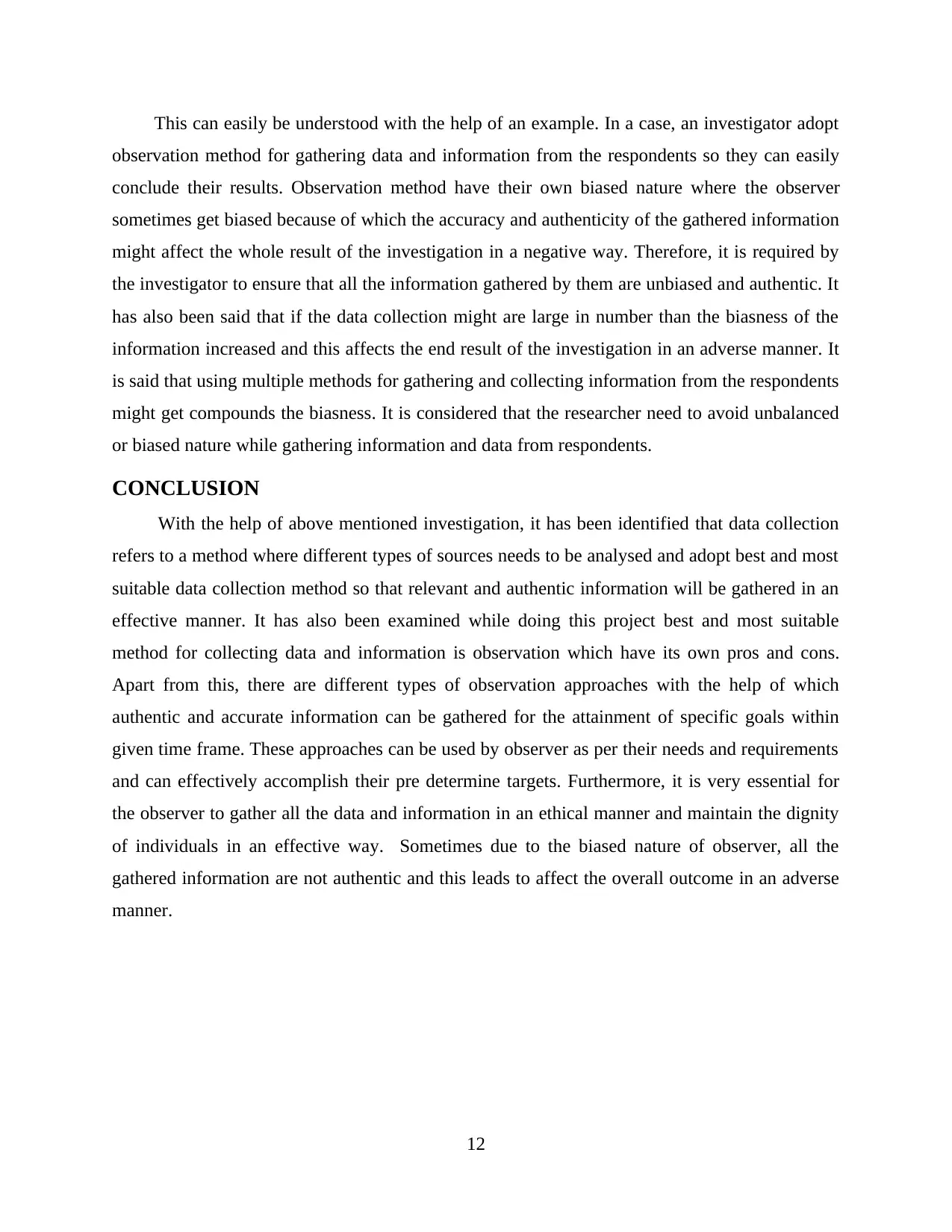
This can easily be understood with the help of an example. In a case, an investigator adopt
observation method for gathering data and information from the respondents so they can easily
conclude their results. Observation method have their own biased nature where the observer
sometimes get biased because of which the accuracy and authenticity of the gathered information
might affect the whole result of the investigation in a negative way. Therefore, it is required by
the investigator to ensure that all the information gathered by them are unbiased and authentic. It
has also been said that if the data collection might are large in number than the biasness of the
information increased and this affects the end result of the investigation in an adverse manner. It
is said that using multiple methods for gathering and collecting information from the respondents
might get compounds the biasness. It is considered that the researcher need to avoid unbalanced
or biased nature while gathering information and data from respondents.
CONCLUSION
With the help of above mentioned investigation, it has been identified that data collection
refers to a method where different types of sources needs to be analysed and adopt best and most
suitable data collection method so that relevant and authentic information will be gathered in an
effective manner. It has also been examined while doing this project best and most suitable
method for collecting data and information is observation which have its own pros and cons.
Apart from this, there are different types of observation approaches with the help of which
authentic and accurate information can be gathered for the attainment of specific goals within
given time frame. These approaches can be used by observer as per their needs and requirements
and can effectively accomplish their pre determine targets. Furthermore, it is very essential for
the observer to gather all the data and information in an ethical manner and maintain the dignity
of individuals in an effective way. Sometimes due to the biased nature of observer, all the
gathered information are not authentic and this leads to affect the overall outcome in an adverse
manner.
12
observation method for gathering data and information from the respondents so they can easily
conclude their results. Observation method have their own biased nature where the observer
sometimes get biased because of which the accuracy and authenticity of the gathered information
might affect the whole result of the investigation in a negative way. Therefore, it is required by
the investigator to ensure that all the information gathered by them are unbiased and authentic. It
has also been said that if the data collection might are large in number than the biasness of the
information increased and this affects the end result of the investigation in an adverse manner. It
is said that using multiple methods for gathering and collecting information from the respondents
might get compounds the biasness. It is considered that the researcher need to avoid unbalanced
or biased nature while gathering information and data from respondents.
CONCLUSION
With the help of above mentioned investigation, it has been identified that data collection
refers to a method where different types of sources needs to be analysed and adopt best and most
suitable data collection method so that relevant and authentic information will be gathered in an
effective manner. It has also been examined while doing this project best and most suitable
method for collecting data and information is observation which have its own pros and cons.
Apart from this, there are different types of observation approaches with the help of which
authentic and accurate information can be gathered for the attainment of specific goals within
given time frame. These approaches can be used by observer as per their needs and requirements
and can effectively accomplish their pre determine targets. Furthermore, it is very essential for
the observer to gather all the data and information in an ethical manner and maintain the dignity
of individuals in an effective way. Sometimes due to the biased nature of observer, all the
gathered information are not authentic and this leads to affect the overall outcome in an adverse
manner.
12
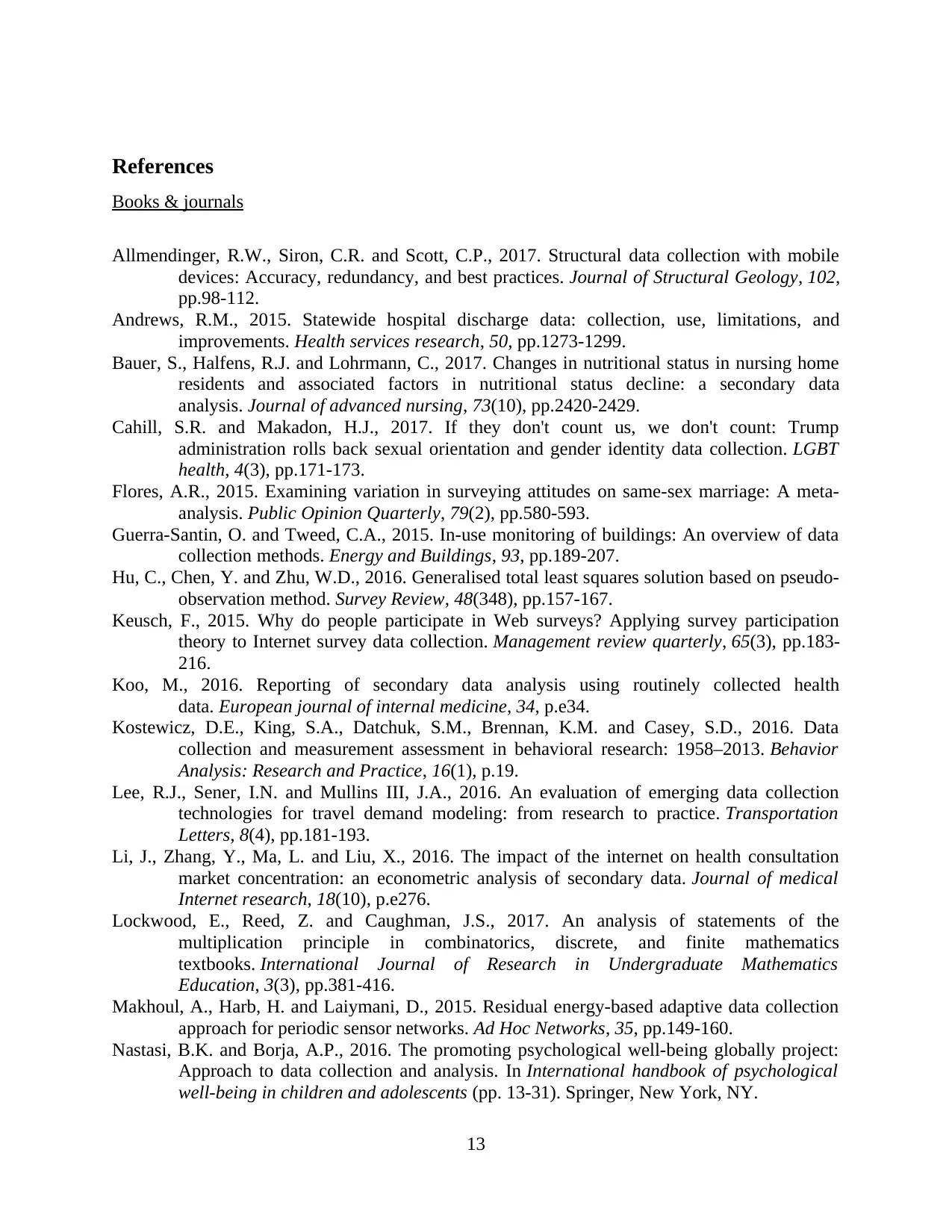
References
Books & journals
Allmendinger, R.W., Siron, C.R. and Scott, C.P., 2017. Structural data collection with mobile
devices: Accuracy, redundancy, and best practices. Journal of Structural Geology, 102,
pp.98-112.
Andrews, R.M., 2015. Statewide hospital discharge data: collection, use, limitations, and
improvements. Health services research, 50, pp.1273-1299.
Bauer, S., Halfens, R.J. and Lohrmann, C., 2017. Changes in nutritional status in nursing home
residents and associated factors in nutritional status decline: a secondary data
analysis. Journal of advanced nursing, 73(10), pp.2420-2429.
Cahill, S.R. and Makadon, H.J., 2017. If they don't count us, we don't count: Trump
administration rolls back sexual orientation and gender identity data collection. LGBT
health, 4(3), pp.171-173.
Flores, A.R., 2015. Examining variation in surveying attitudes on same-sex marriage: A meta-
analysis. Public Opinion Quarterly, 79(2), pp.580-593.
Guerra-Santin, O. and Tweed, C.A., 2015. In-use monitoring of buildings: An overview of data
collection methods. Energy and Buildings, 93, pp.189-207.
Hu, C., Chen, Y. and Zhu, W.D., 2016. Generalised total least squares solution based on pseudo-
observation method. Survey Review, 48(348), pp.157-167.
Keusch, F., 2015. Why do people participate in Web surveys? Applying survey participation
theory to Internet survey data collection. Management review quarterly, 65(3), pp.183-
216.
Koo, M., 2016. Reporting of secondary data analysis using routinely collected health
data. European journal of internal medicine, 34, p.e34.
Kostewicz, D.E., King, S.A., Datchuk, S.M., Brennan, K.M. and Casey, S.D., 2016. Data
collection and measurement assessment in behavioral research: 1958–2013. Behavior
Analysis: Research and Practice, 16(1), p.19.
Lee, R.J., Sener, I.N. and Mullins III, J.A., 2016. An evaluation of emerging data collection
technologies for travel demand modeling: from research to practice. Transportation
Letters, 8(4), pp.181-193.
Li, J., Zhang, Y., Ma, L. and Liu, X., 2016. The impact of the internet on health consultation
market concentration: an econometric analysis of secondary data. Journal of medical
Internet research, 18(10), p.e276.
Lockwood, E., Reed, Z. and Caughman, J.S., 2017. An analysis of statements of the
multiplication principle in combinatorics, discrete, and finite mathematics
textbooks. International Journal of Research in Undergraduate Mathematics
Education, 3(3), pp.381-416.
Makhoul, A., Harb, H. and Laiymani, D., 2015. Residual energy-based adaptive data collection
approach for periodic sensor networks. Ad Hoc Networks, 35, pp.149-160.
Nastasi, B.K. and Borja, A.P., 2016. The promoting psychological well-being globally project:
Approach to data collection and analysis. In International handbook of psychological
well-being in children and adolescents (pp. 13-31). Springer, New York, NY.
13
Books & journals
Allmendinger, R.W., Siron, C.R. and Scott, C.P., 2017. Structural data collection with mobile
devices: Accuracy, redundancy, and best practices. Journal of Structural Geology, 102,
pp.98-112.
Andrews, R.M., 2015. Statewide hospital discharge data: collection, use, limitations, and
improvements. Health services research, 50, pp.1273-1299.
Bauer, S., Halfens, R.J. and Lohrmann, C., 2017. Changes in nutritional status in nursing home
residents and associated factors in nutritional status decline: a secondary data
analysis. Journal of advanced nursing, 73(10), pp.2420-2429.
Cahill, S.R. and Makadon, H.J., 2017. If they don't count us, we don't count: Trump
administration rolls back sexual orientation and gender identity data collection. LGBT
health, 4(3), pp.171-173.
Flores, A.R., 2015. Examining variation in surveying attitudes on same-sex marriage: A meta-
analysis. Public Opinion Quarterly, 79(2), pp.580-593.
Guerra-Santin, O. and Tweed, C.A., 2015. In-use monitoring of buildings: An overview of data
collection methods. Energy and Buildings, 93, pp.189-207.
Hu, C., Chen, Y. and Zhu, W.D., 2016. Generalised total least squares solution based on pseudo-
observation method. Survey Review, 48(348), pp.157-167.
Keusch, F., 2015. Why do people participate in Web surveys? Applying survey participation
theory to Internet survey data collection. Management review quarterly, 65(3), pp.183-
216.
Koo, M., 2016. Reporting of secondary data analysis using routinely collected health
data. European journal of internal medicine, 34, p.e34.
Kostewicz, D.E., King, S.A., Datchuk, S.M., Brennan, K.M. and Casey, S.D., 2016. Data
collection and measurement assessment in behavioral research: 1958–2013. Behavior
Analysis: Research and Practice, 16(1), p.19.
Lee, R.J., Sener, I.N. and Mullins III, J.A., 2016. An evaluation of emerging data collection
technologies for travel demand modeling: from research to practice. Transportation
Letters, 8(4), pp.181-193.
Li, J., Zhang, Y., Ma, L. and Liu, X., 2016. The impact of the internet on health consultation
market concentration: an econometric analysis of secondary data. Journal of medical
Internet research, 18(10), p.e276.
Lockwood, E., Reed, Z. and Caughman, J.S., 2017. An analysis of statements of the
multiplication principle in combinatorics, discrete, and finite mathematics
textbooks. International Journal of Research in Undergraduate Mathematics
Education, 3(3), pp.381-416.
Makhoul, A., Harb, H. and Laiymani, D., 2015. Residual energy-based adaptive data collection
approach for periodic sensor networks. Ad Hoc Networks, 35, pp.149-160.
Nastasi, B.K. and Borja, A.P., 2016. The promoting psychological well-being globally project:
Approach to data collection and analysis. In International handbook of psychological
well-being in children and adolescents (pp. 13-31). Springer, New York, NY.
13
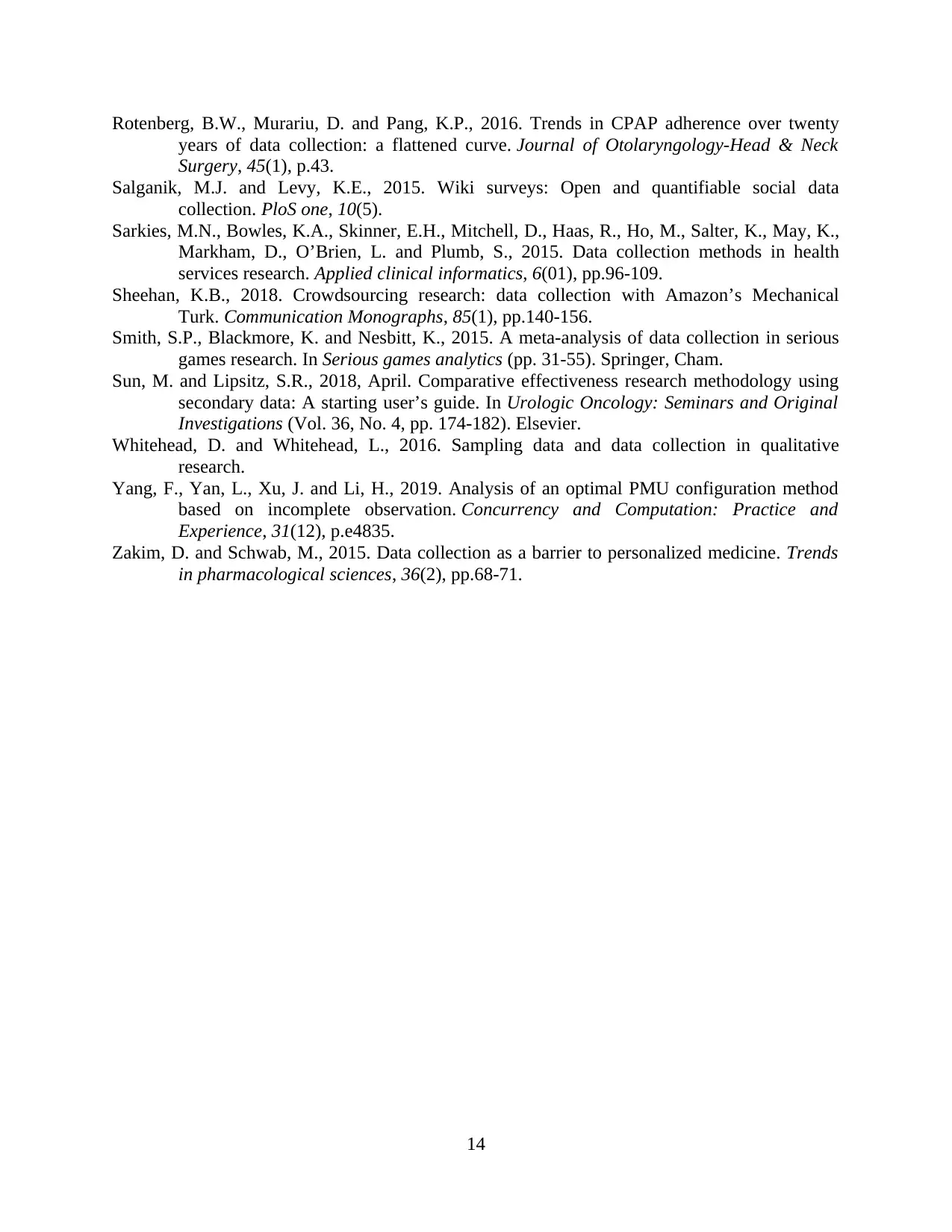
Rotenberg, B.W., Murariu, D. and Pang, K.P., 2016. Trends in CPAP adherence over twenty
years of data collection: a flattened curve. Journal of Otolaryngology-Head & Neck
Surgery, 45(1), p.43.
Salganik, M.J. and Levy, K.E., 2015. Wiki surveys: Open and quantifiable social data
collection. PloS one, 10(5).
Sarkies, M.N., Bowles, K.A., Skinner, E.H., Mitchell, D., Haas, R., Ho, M., Salter, K., May, K.,
Markham, D., O’Brien, L. and Plumb, S., 2015. Data collection methods in health
services research. Applied clinical informatics, 6(01), pp.96-109.
Sheehan, K.B., 2018. Crowdsourcing research: data collection with Amazon’s Mechanical
Turk. Communication Monographs, 85(1), pp.140-156.
Smith, S.P., Blackmore, K. and Nesbitt, K., 2015. A meta-analysis of data collection in serious
games research. In Serious games analytics (pp. 31-55). Springer, Cham.
Sun, M. and Lipsitz, S.R., 2018, April. Comparative effectiveness research methodology using
secondary data: A starting user’s guide. In Urologic Oncology: Seminars and Original
Investigations (Vol. 36, No. 4, pp. 174-182). Elsevier.
Whitehead, D. and Whitehead, L., 2016. Sampling data and data collection in qualitative
research.
Yang, F., Yan, L., Xu, J. and Li, H., 2019. Analysis of an optimal PMU configuration method
based on incomplete observation. Concurrency and Computation: Practice and
Experience, 31(12), p.e4835.
Zakim, D. and Schwab, M., 2015. Data collection as a barrier to personalized medicine. Trends
in pharmacological sciences, 36(2), pp.68-71.
14
years of data collection: a flattened curve. Journal of Otolaryngology-Head & Neck
Surgery, 45(1), p.43.
Salganik, M.J. and Levy, K.E., 2015. Wiki surveys: Open and quantifiable social data
collection. PloS one, 10(5).
Sarkies, M.N., Bowles, K.A., Skinner, E.H., Mitchell, D., Haas, R., Ho, M., Salter, K., May, K.,
Markham, D., O’Brien, L. and Plumb, S., 2015. Data collection methods in health
services research. Applied clinical informatics, 6(01), pp.96-109.
Sheehan, K.B., 2018. Crowdsourcing research: data collection with Amazon’s Mechanical
Turk. Communication Monographs, 85(1), pp.140-156.
Smith, S.P., Blackmore, K. and Nesbitt, K., 2015. A meta-analysis of data collection in serious
games research. In Serious games analytics (pp. 31-55). Springer, Cham.
Sun, M. and Lipsitz, S.R., 2018, April. Comparative effectiveness research methodology using
secondary data: A starting user’s guide. In Urologic Oncology: Seminars and Original
Investigations (Vol. 36, No. 4, pp. 174-182). Elsevier.
Whitehead, D. and Whitehead, L., 2016. Sampling data and data collection in qualitative
research.
Yang, F., Yan, L., Xu, J. and Li, H., 2019. Analysis of an optimal PMU configuration method
based on incomplete observation. Concurrency and Computation: Practice and
Experience, 31(12), p.e4835.
Zakim, D. and Schwab, M., 2015. Data collection as a barrier to personalized medicine. Trends
in pharmacological sciences, 36(2), pp.68-71.
14
1 out of 16
Related Documents
Your All-in-One AI-Powered Toolkit for Academic Success.
+13062052269
info@desklib.com
Available 24*7 on WhatsApp / Email
![[object Object]](/_next/static/media/star-bottom.7253800d.svg)
Unlock your academic potential
© 2024 | Zucol Services PVT LTD | All rights reserved.





